The document discusses the atomistic mechanics of nanoscale structures, focusing on static and dynamic analyses of materials like carbon nanotubes, fullerenes, and graphene. It details methodologies such as the atomistic finite element method and explores various research areas including the mechanical properties of nanoscale objects and bio sensors. The findings include analyses of vibration spectra, buckling mechanisms, and the impact of defects on the mechanical properties of carbon nanotubes.
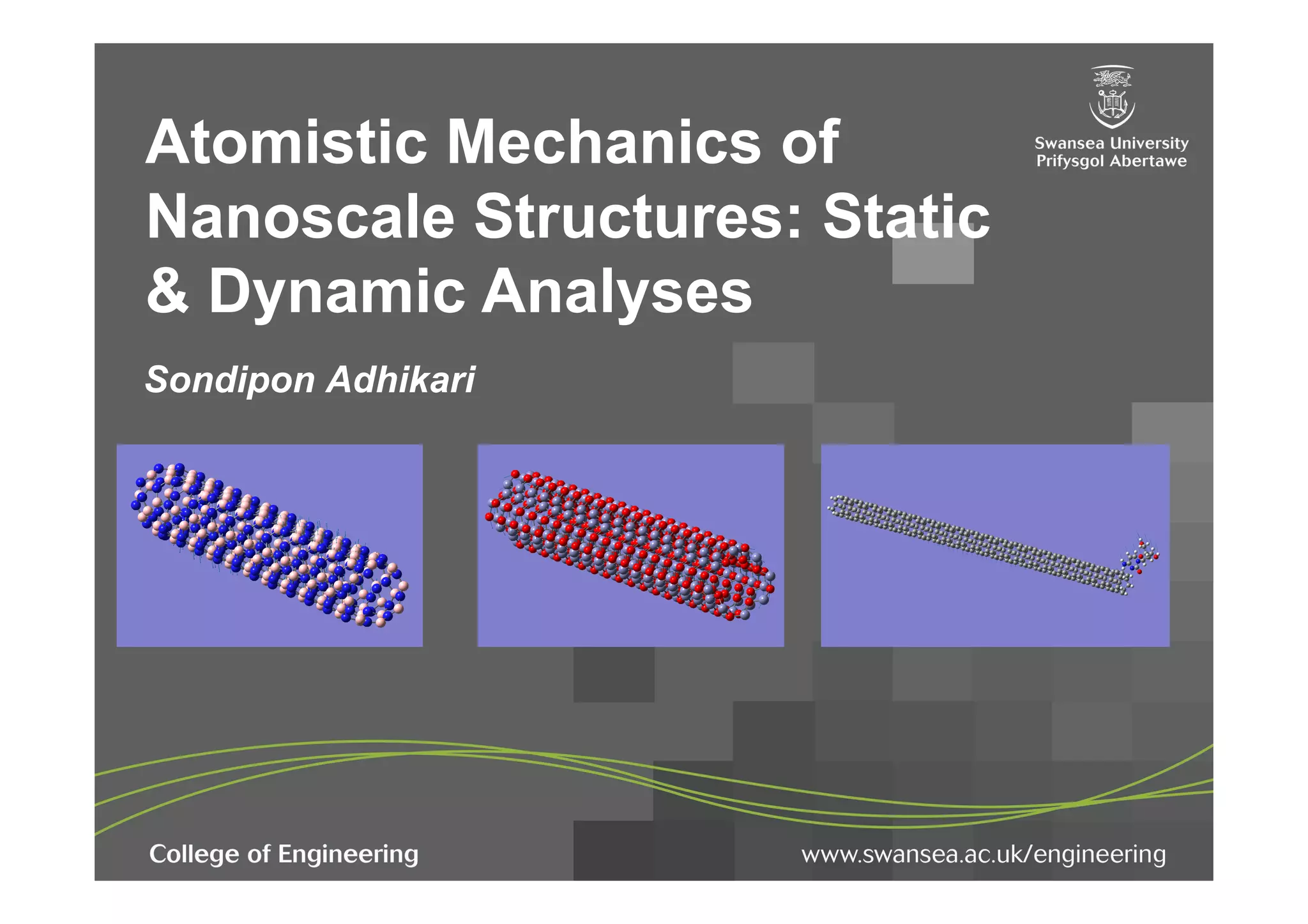



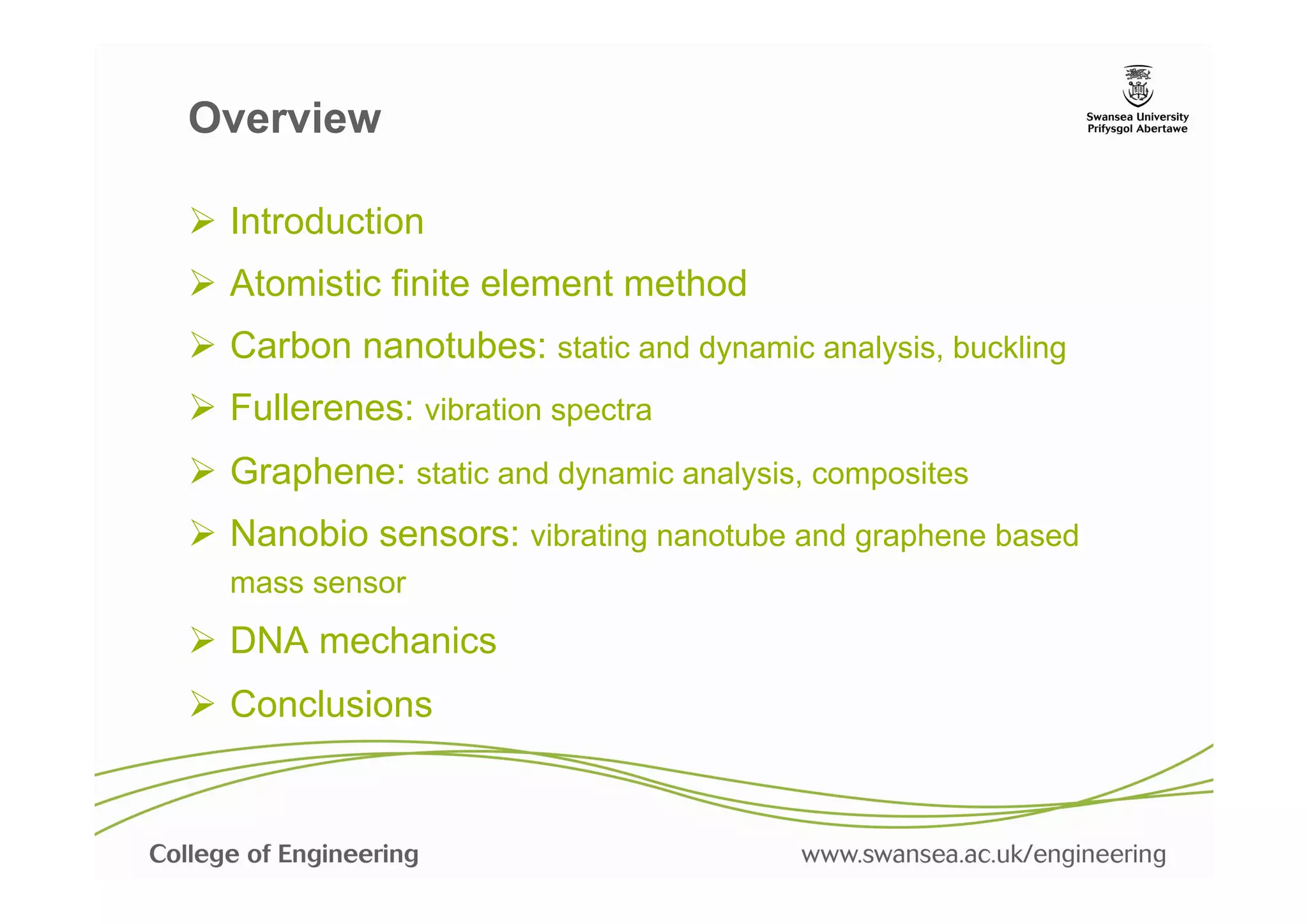

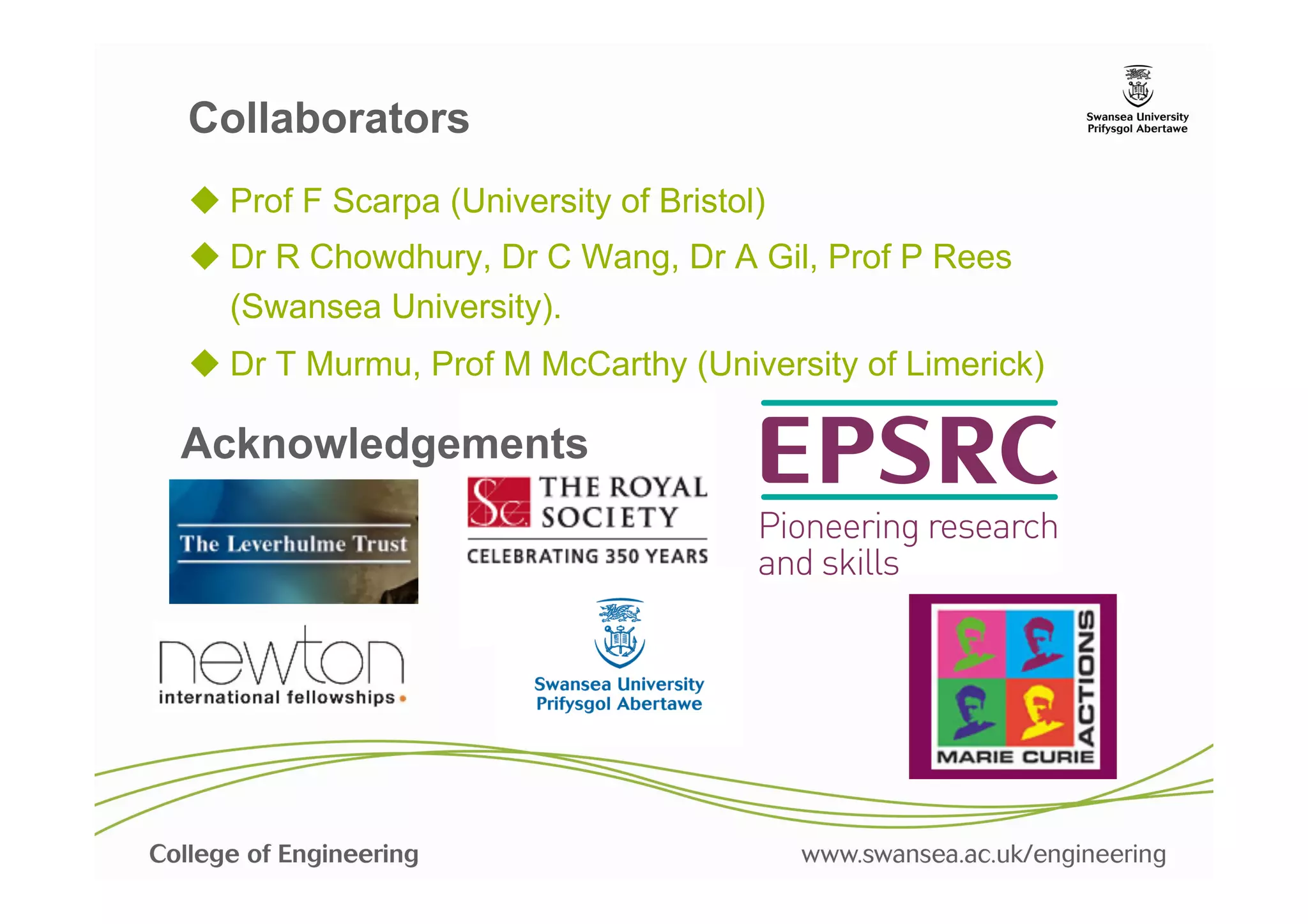
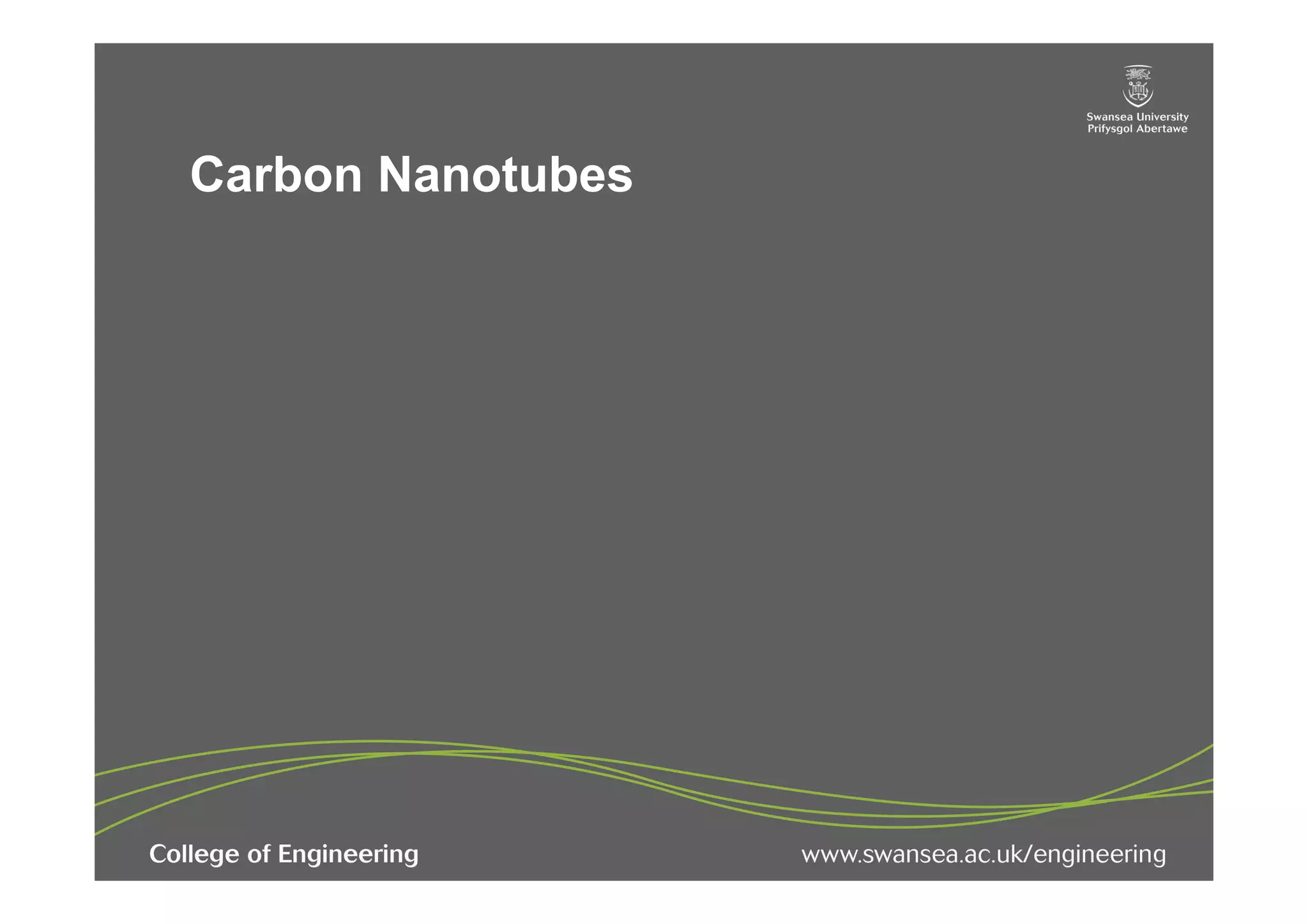
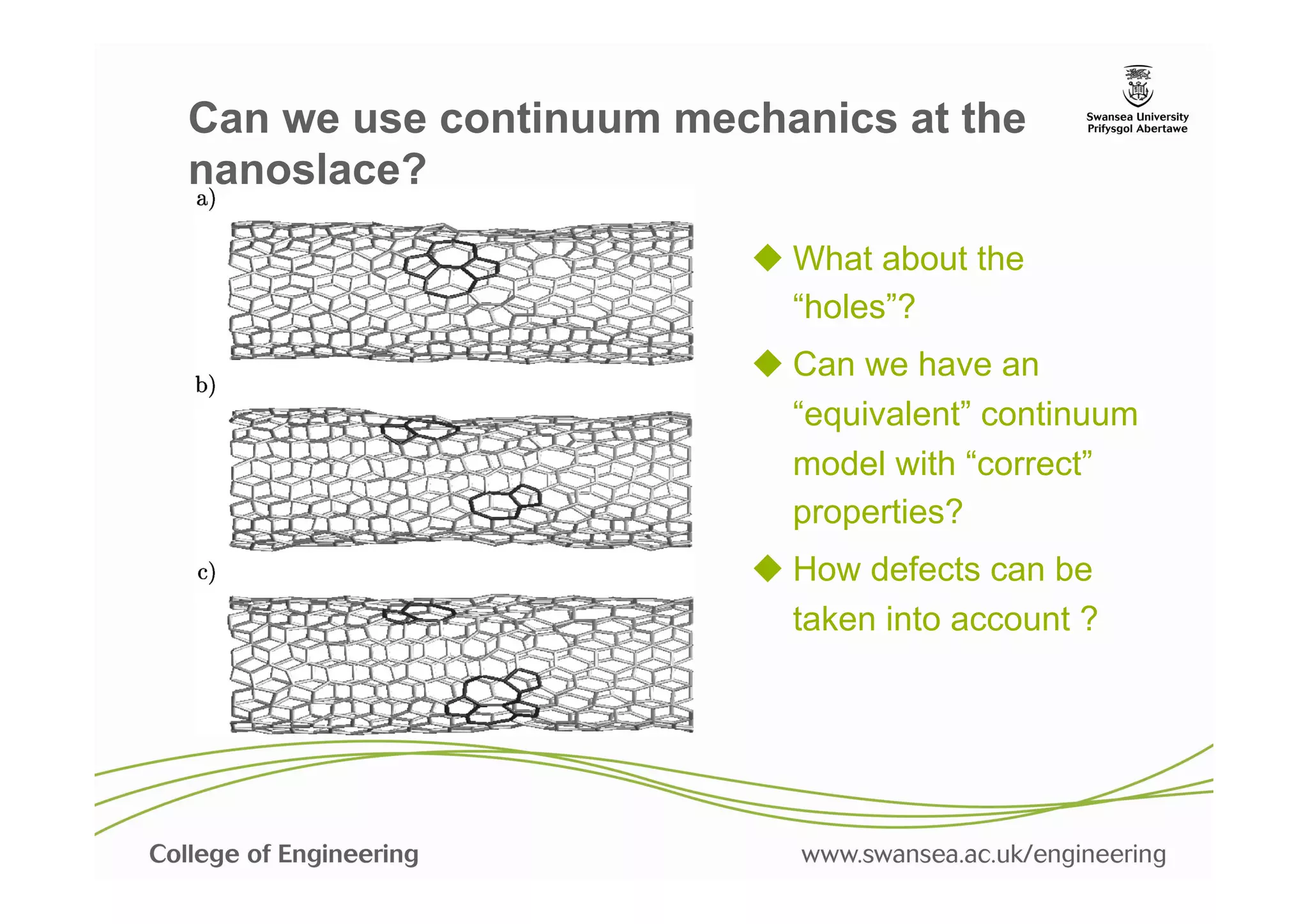
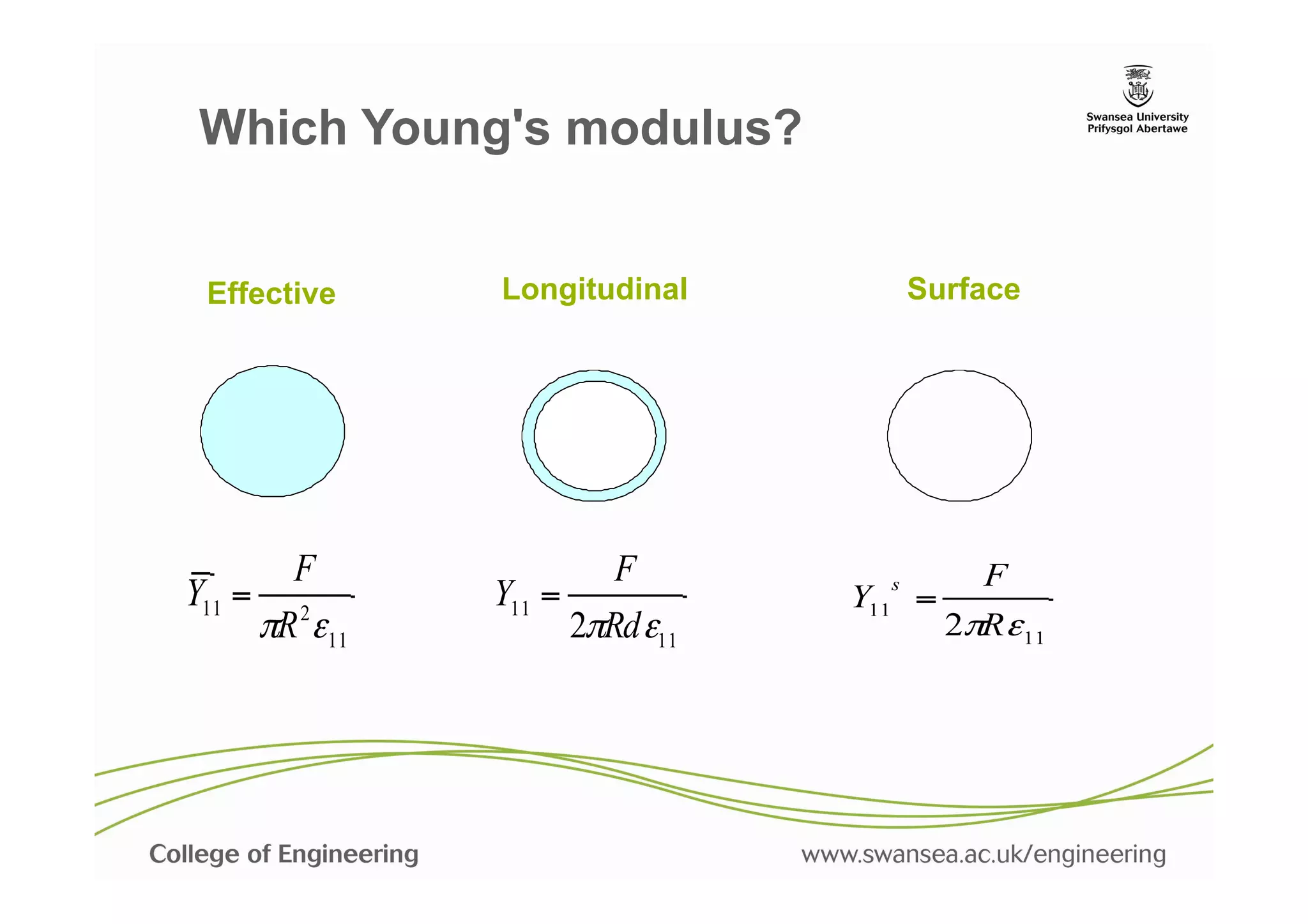
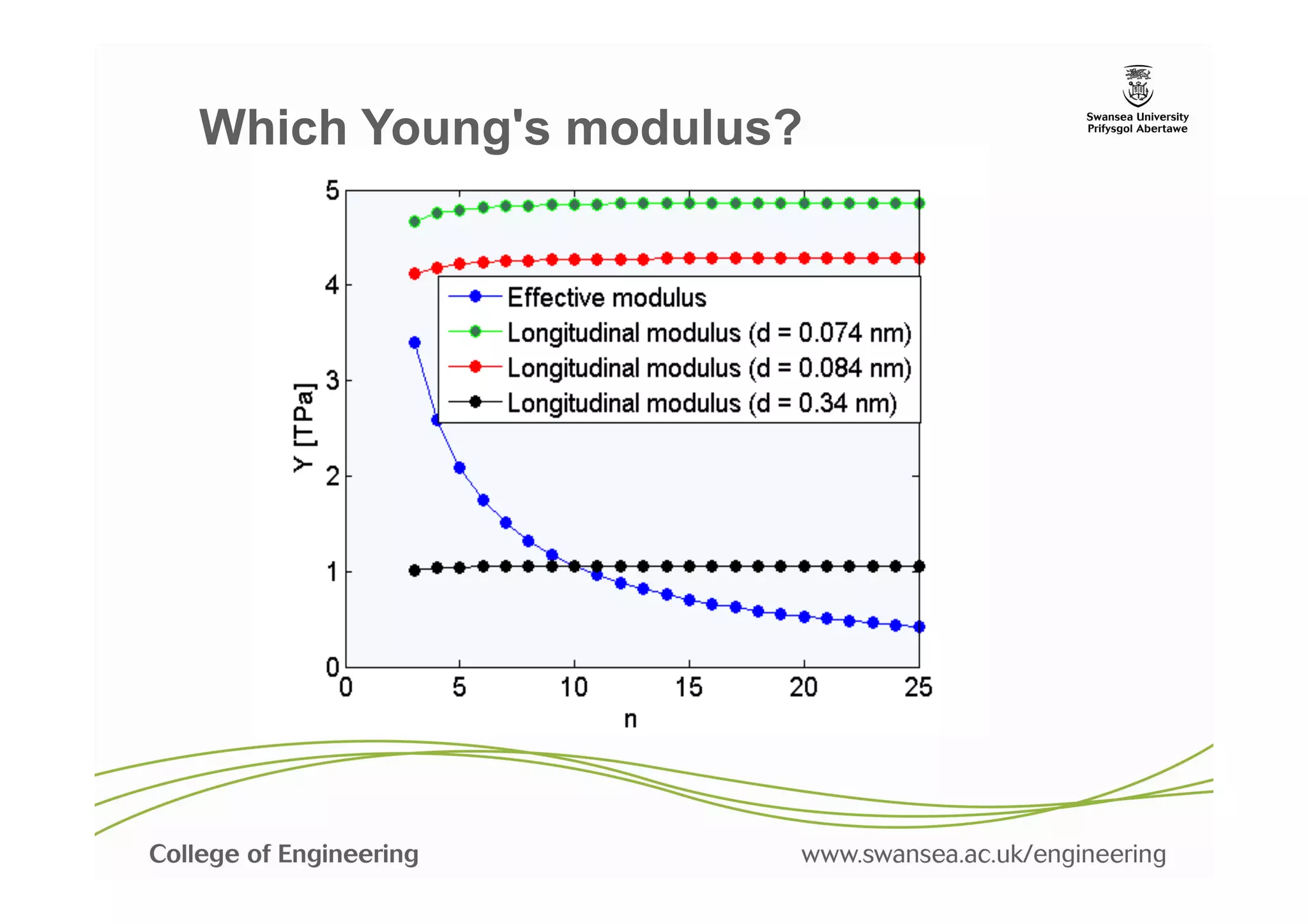
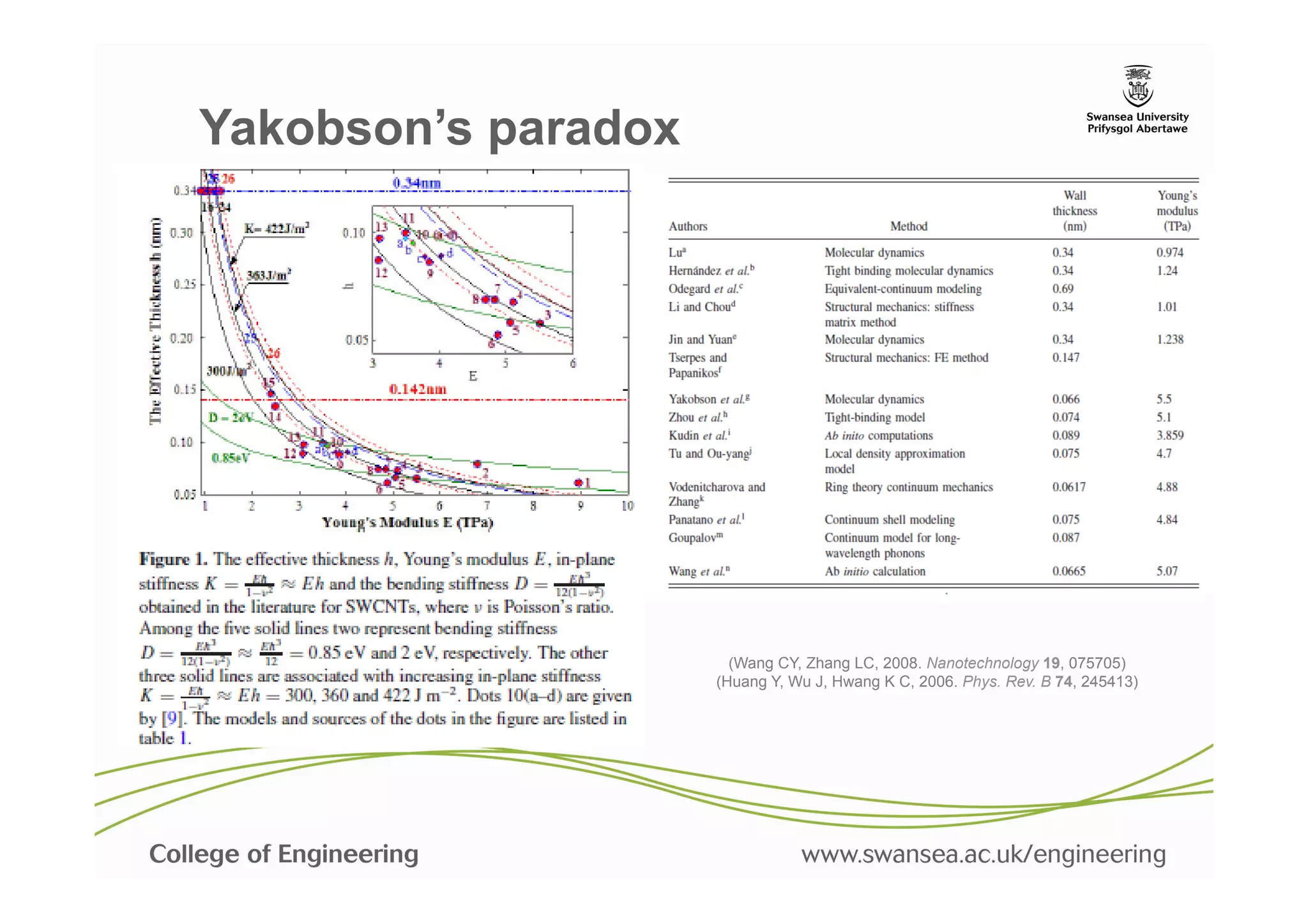
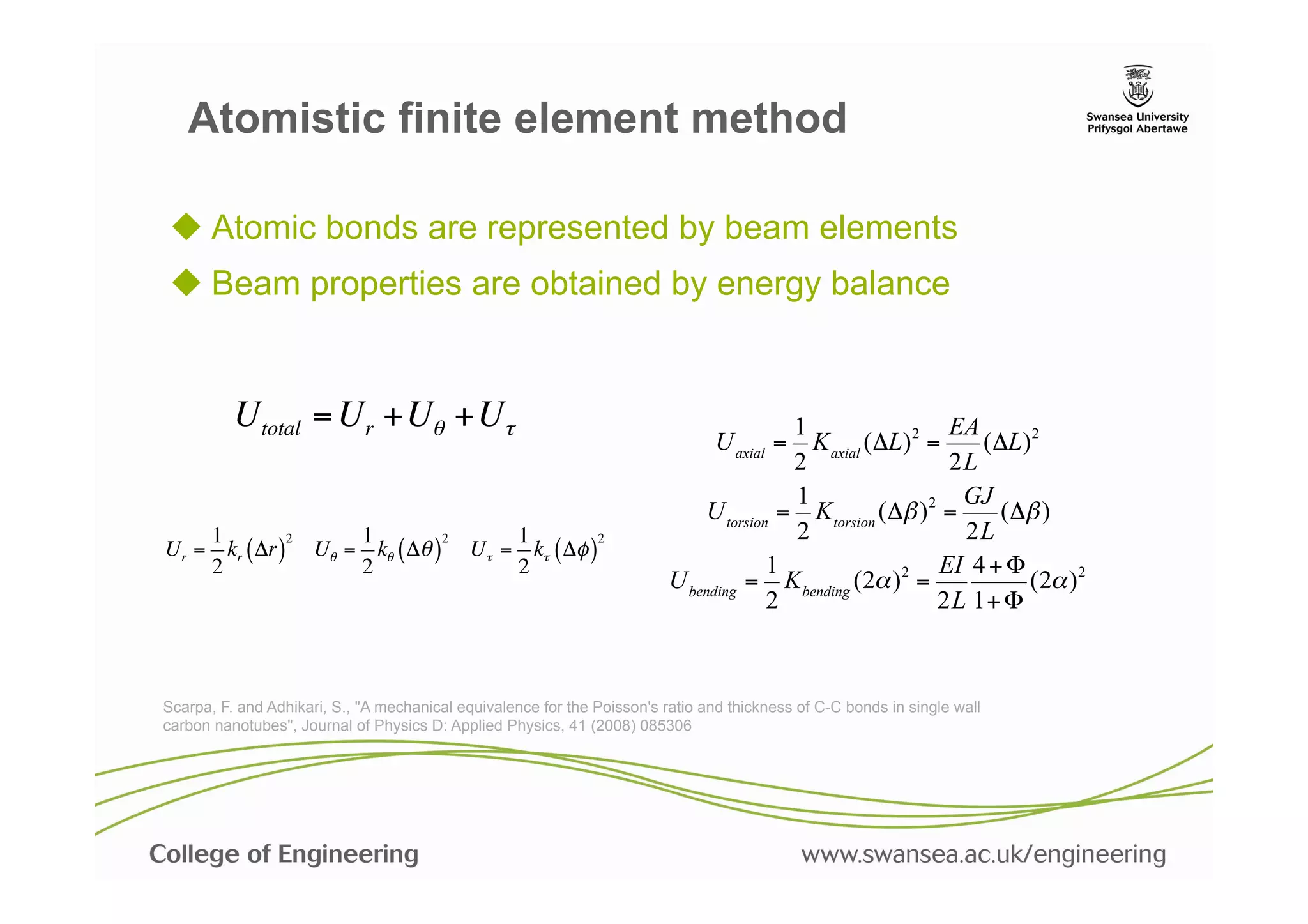
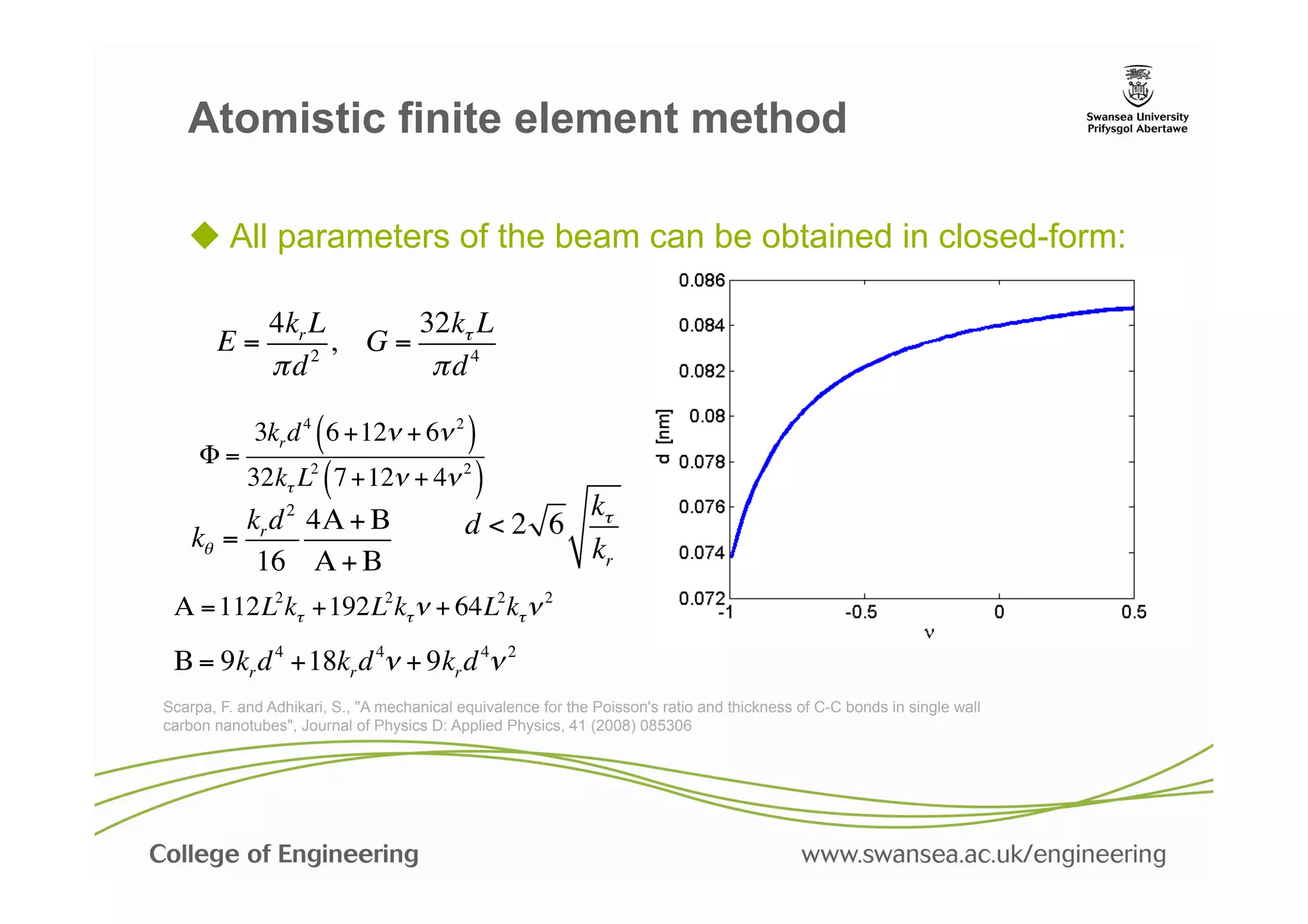
![Atomistic Structural Mechanics
For space frames:
[K ] {u} = {f } [K] à stiffness matrix
{u} à nodal displacement vector
{f} à nodal force vector
(Weaver Jr., W. and Gere, J.M., 1990. Matrix Analysis of
Framed Structures. (third ed.),, Van Nostrand Reinhold, New
York)](https://image.slidesharecdn.com/nanomechsd-pptx-130121050031-phpapp02/75/Statics-and-dynamics-of-nanoscale-structures-15-2048.jpg)
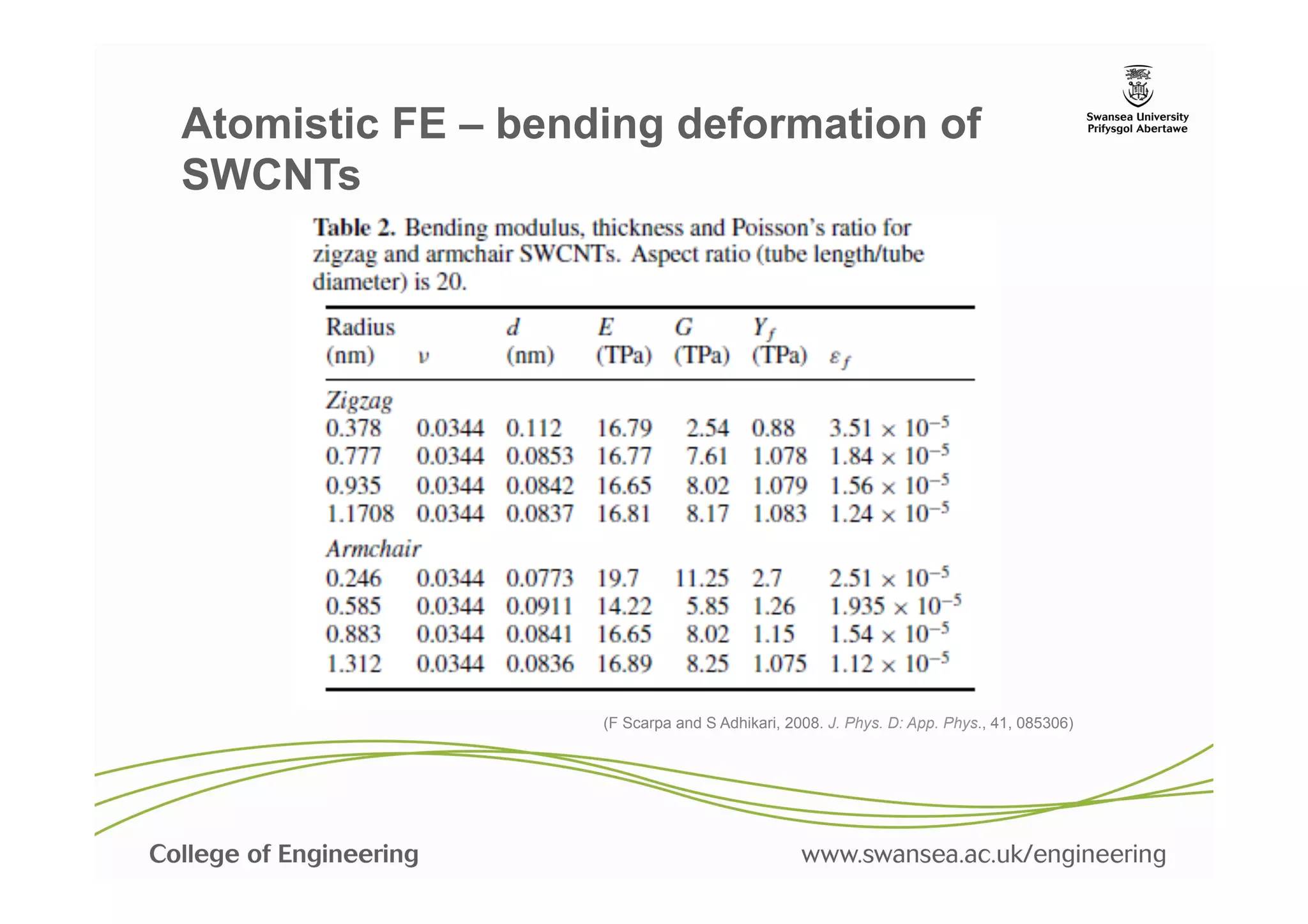
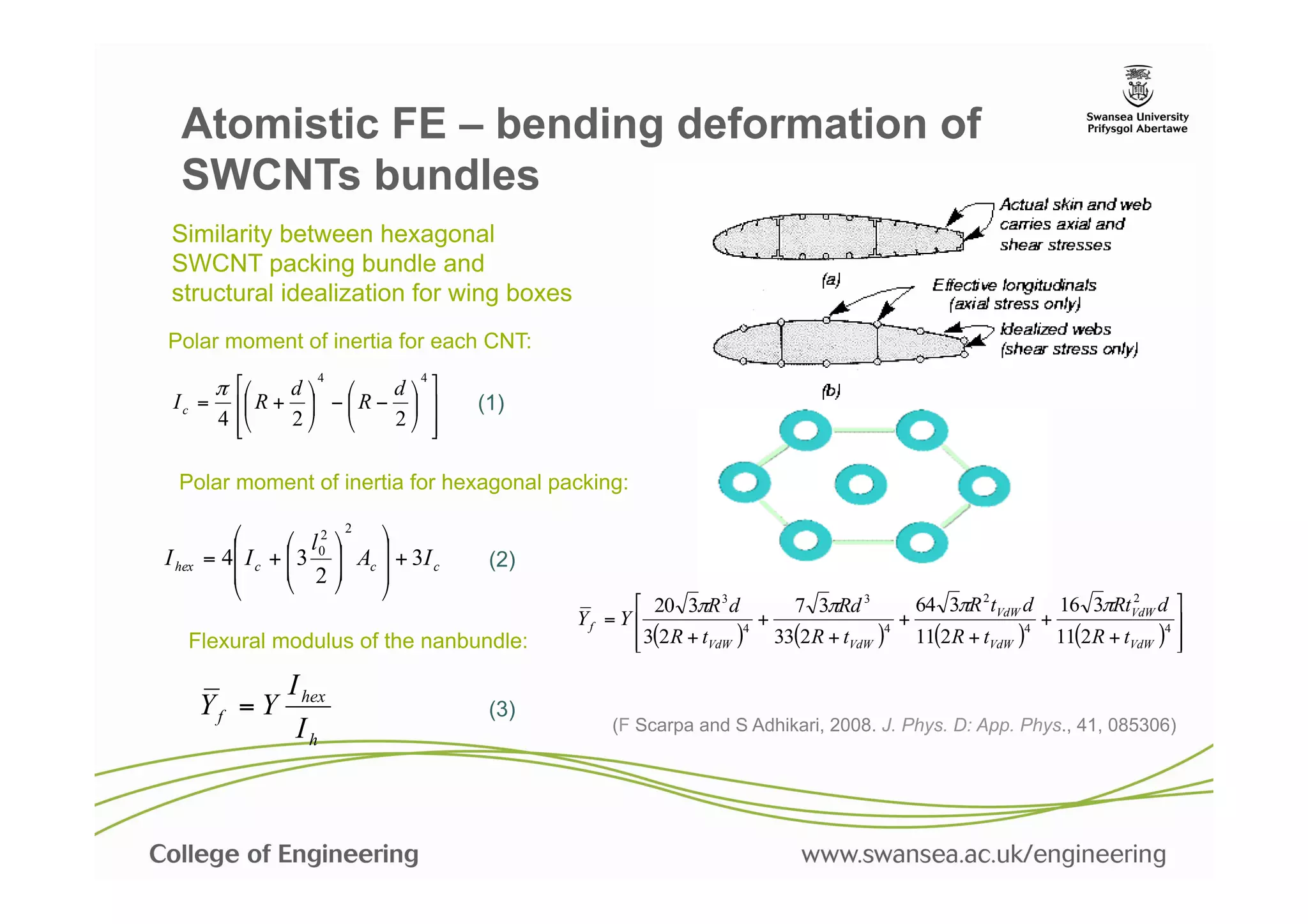
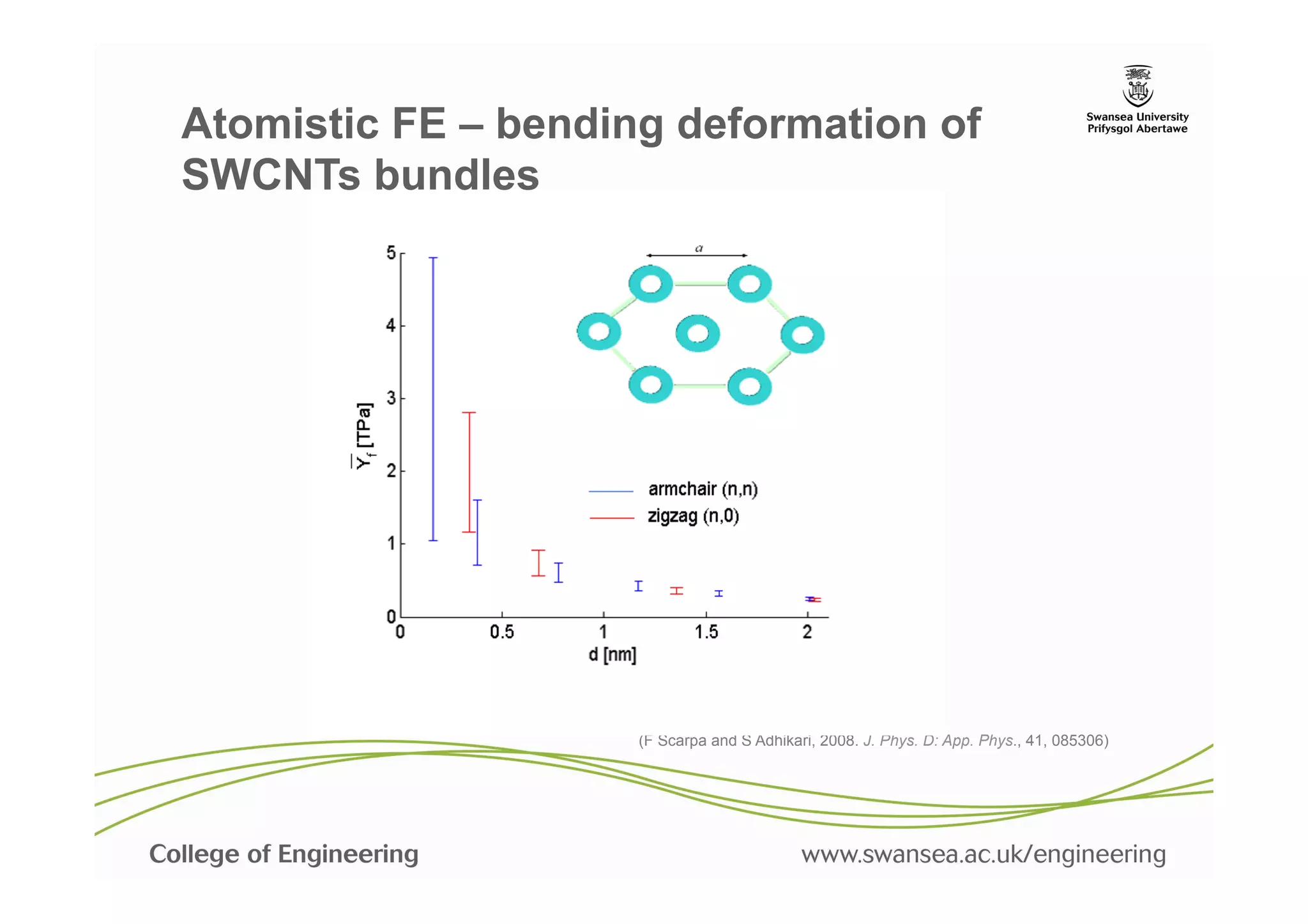
![Buckling of Carbon nanotubes
(a) Molecular dynamics
(b) Hyperplastic atomistic FE (Ogden
strain energy density function )
Comparison of buckling
mechanisms in a (5,5) SWCNT
with 5.0 nm length. Flores, E. I. S., Adhikari, S., Friswell, M. I. and Scarpa, F., "Hyperelastic axial
buckling of single wall carbon nanotubes", Physica E: Low-dimensional
Systems and Nanostructures, 44[2] (2011), pp. 525-529.](https://image.slidesharecdn.com/nanomechsd-pptx-130121050031-phpapp02/75/Statics-and-dynamics-of-nanoscale-structures-19-2048.jpg)
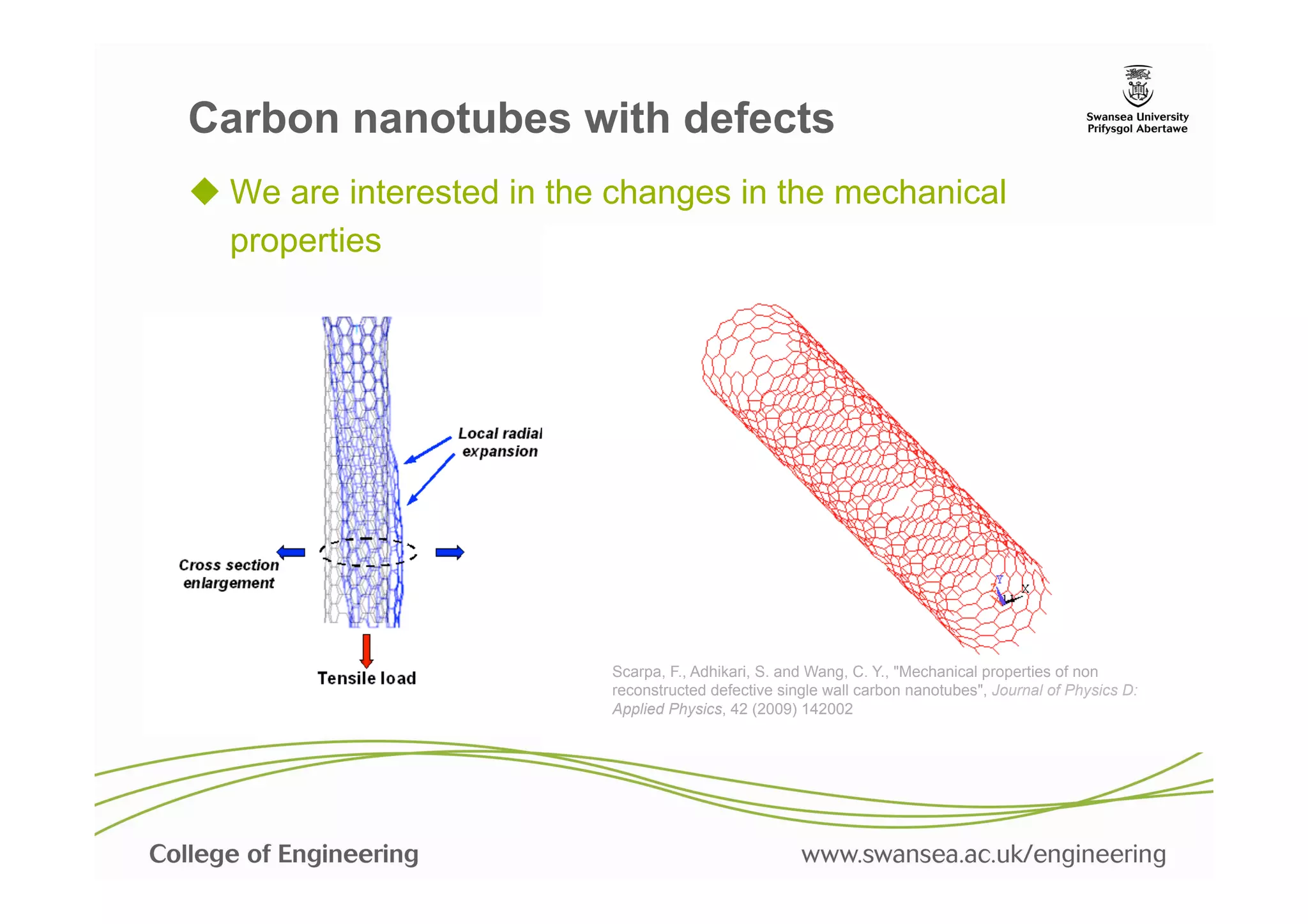
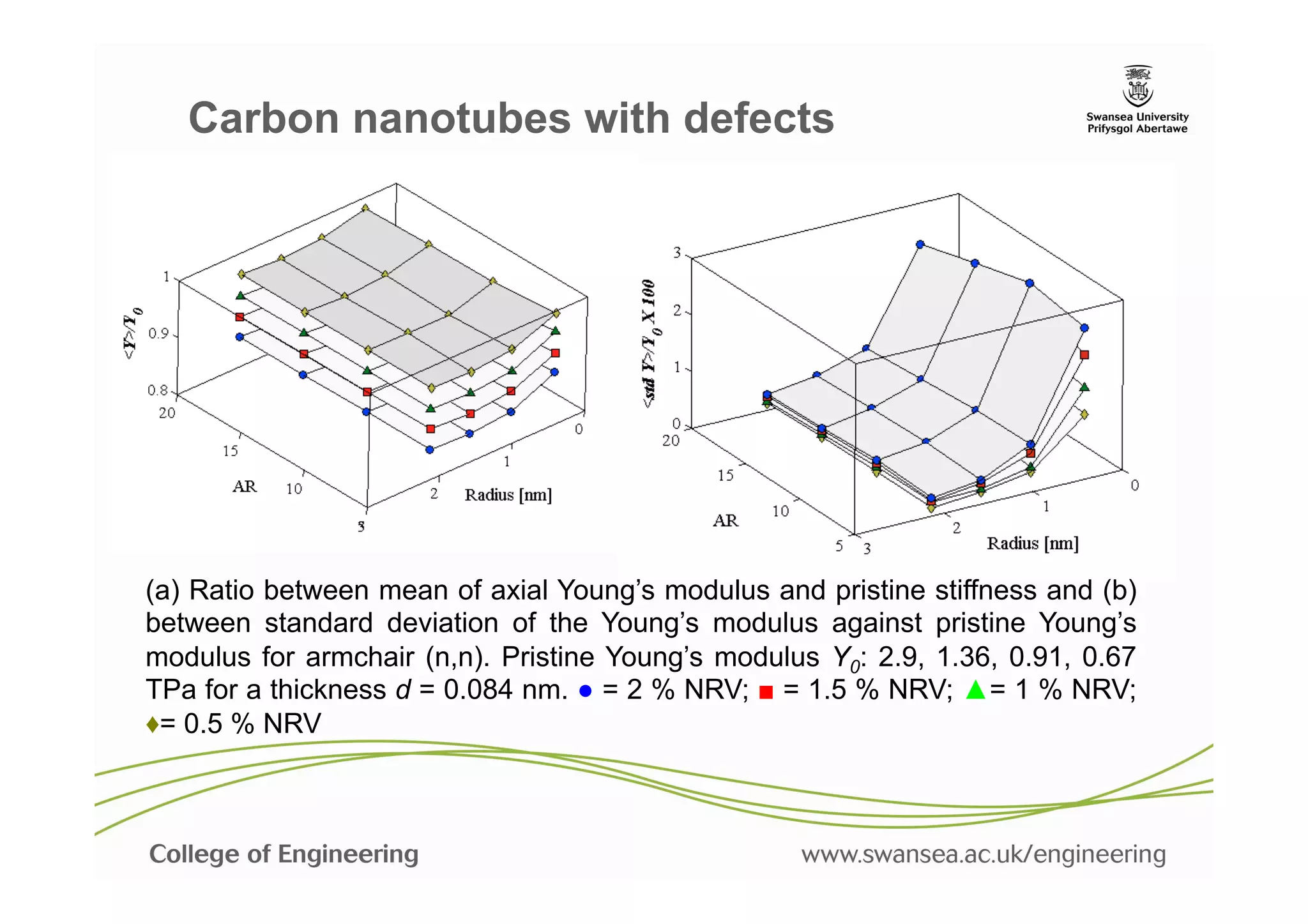

![Vibration spectra of fullerene family
The variation of the first natural frequency across the
the complete range of fullerenes. The 8 spherical
type of fullerenes include C60 , C80 , C180 , C60 ,
C240 , C260 , C320 , C500 , C720
and the 8 ellipsoidal (or non-spherical) type of
fullerenes include C20 , C30 , C40 , C50 , C70 , C90 ,
C100 and C540 (fullerenes are not drawn in scale).
Adhikari, S. and Chowdhury, R., "Vibration spectra of fullerene family", Physics
Letters A, 375[22] (2011), pp. 1276-1280.](https://image.slidesharecdn.com/nanomechsd-pptx-130121050031-phpapp02/75/Statics-and-dynamics-of-nanoscale-structures-23-2048.jpg)
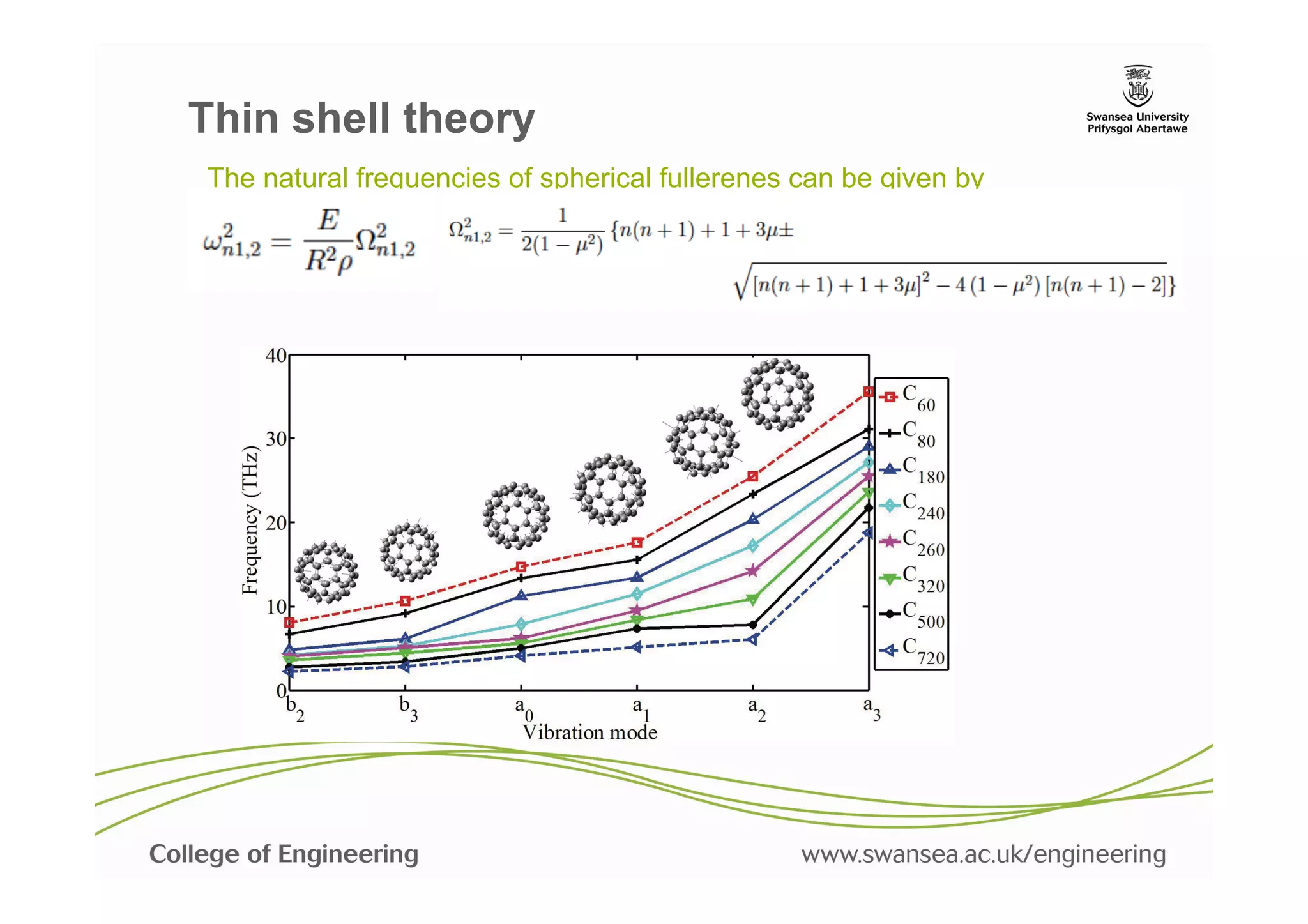
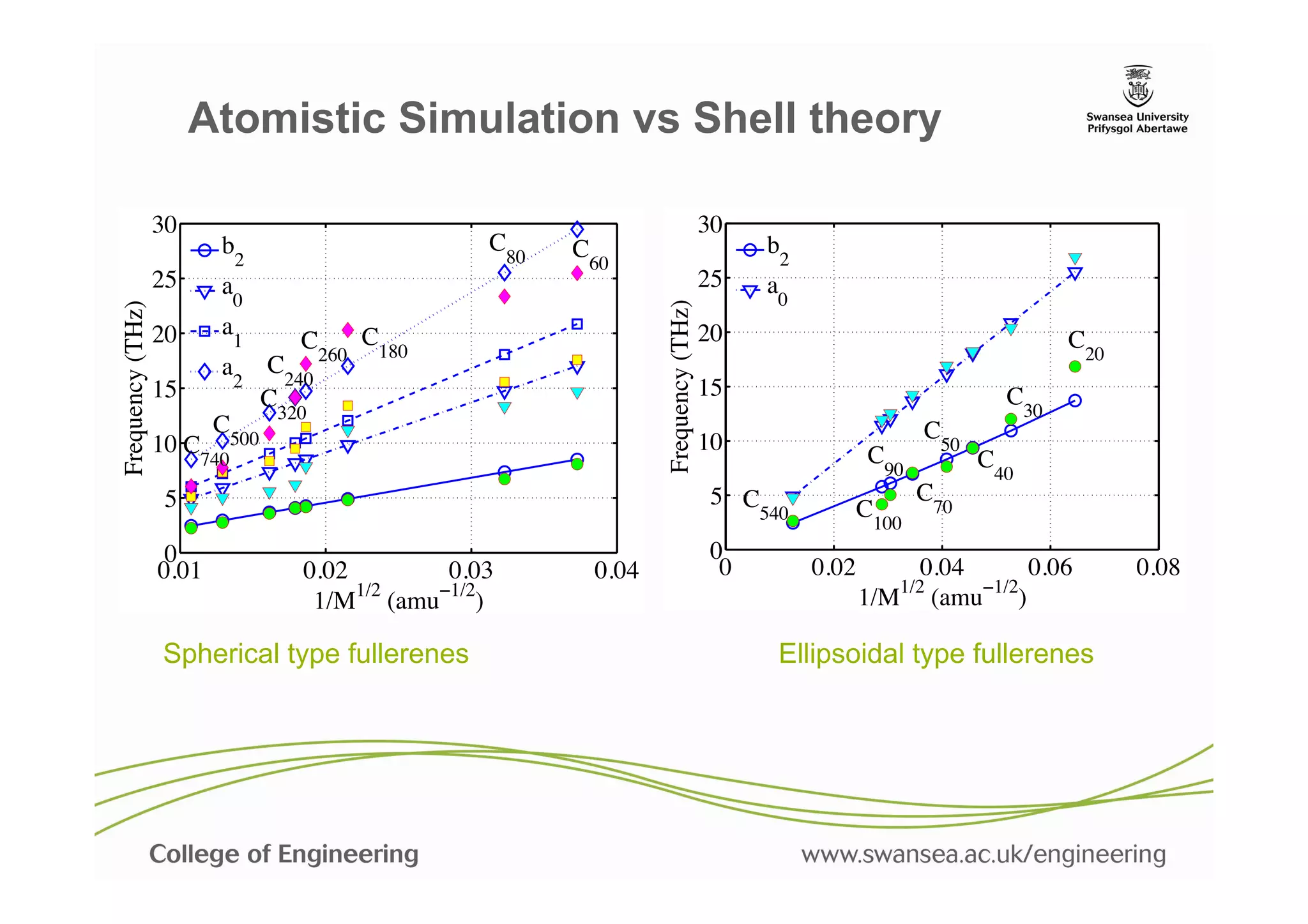
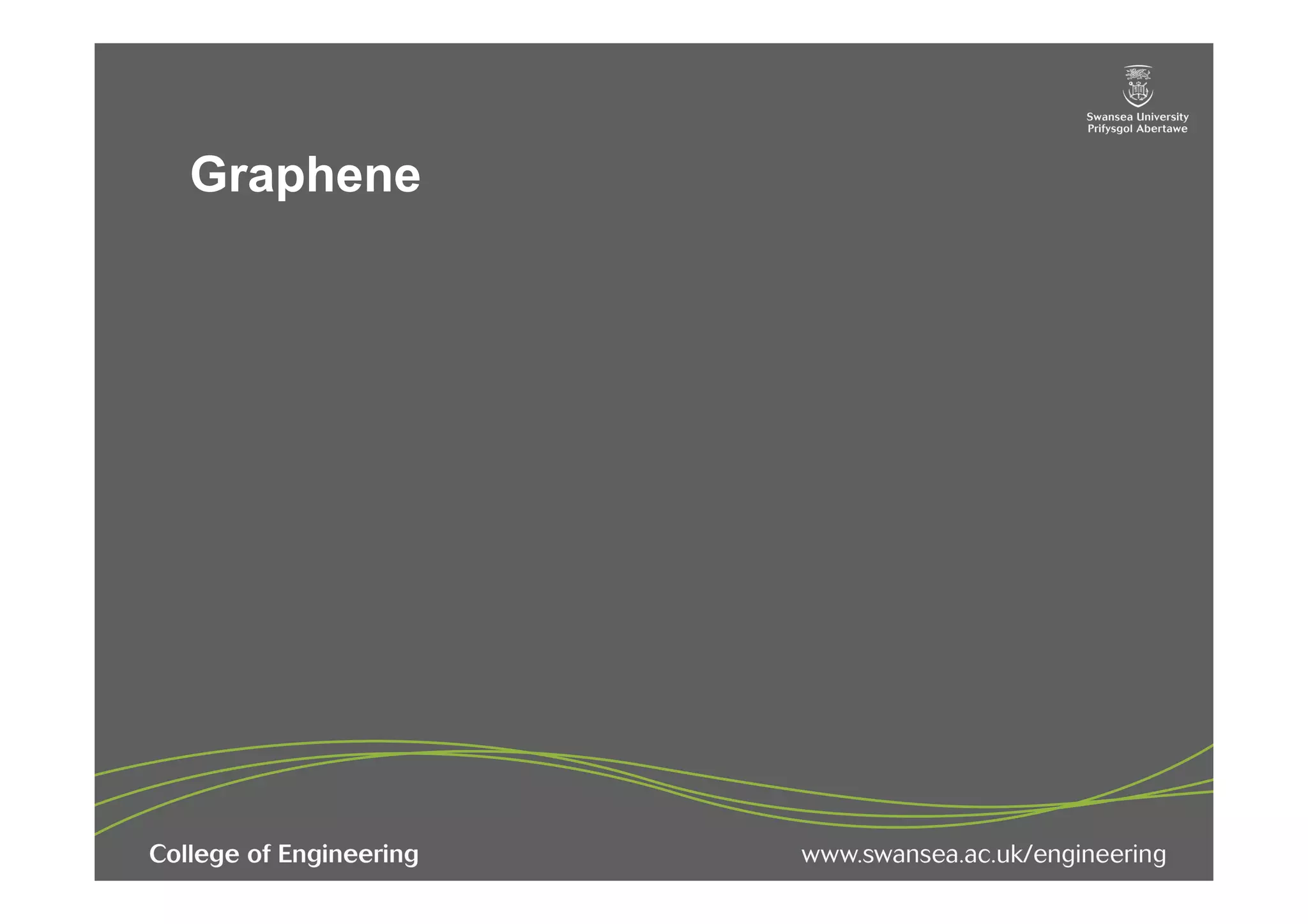

![Atomistic FE vs Continuum – SLGS
Circular SLGS (R = 9: 5 nm) Deformation of rectangular SLGS
under central loading. Distribution (15.1 x 13.03 nm2) under central
of equivalent membrane stresses. loading.
Scarpa, F., Adhikari, S., Gil, A. J. and Remillat, C., "The bending of single layer graphene
sheets: Lattice versus continuum approach", Nanotechnology, 21[12] (2010), pp. 125702:1-9.](https://image.slidesharecdn.com/nanomechsd-pptx-130121050031-phpapp02/75/Statics-and-dynamics-of-nanoscale-structures-28-2048.jpg)
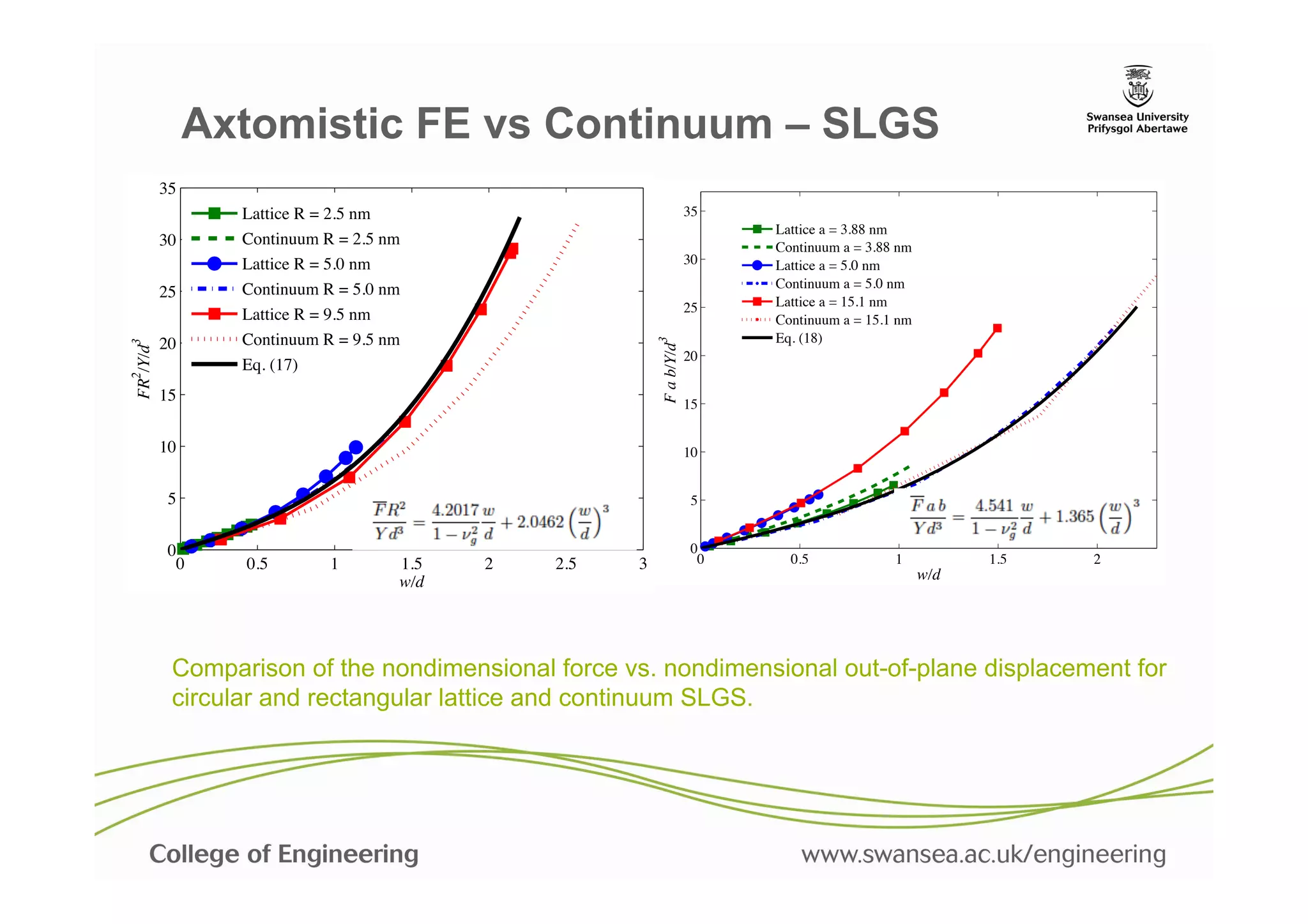
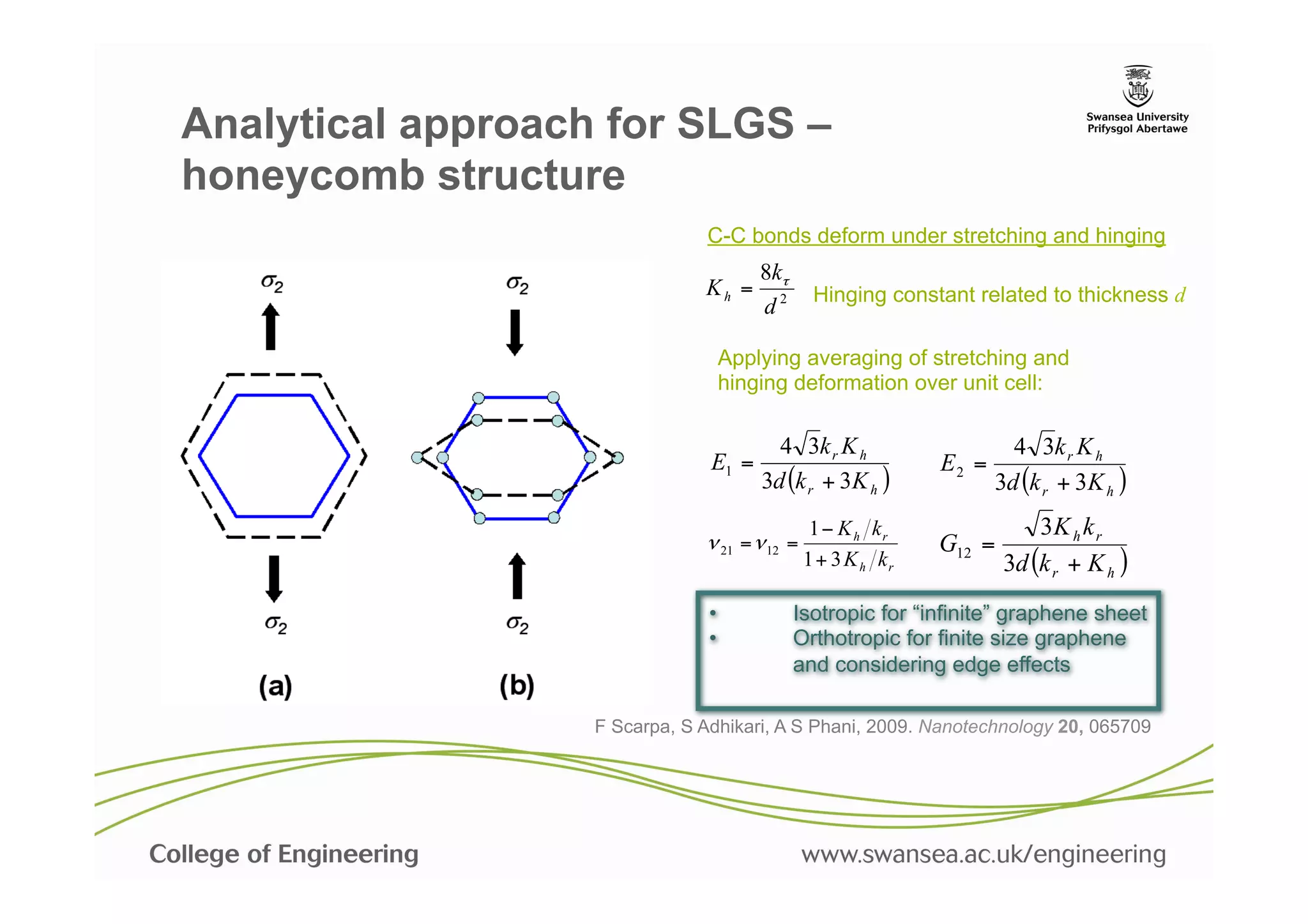
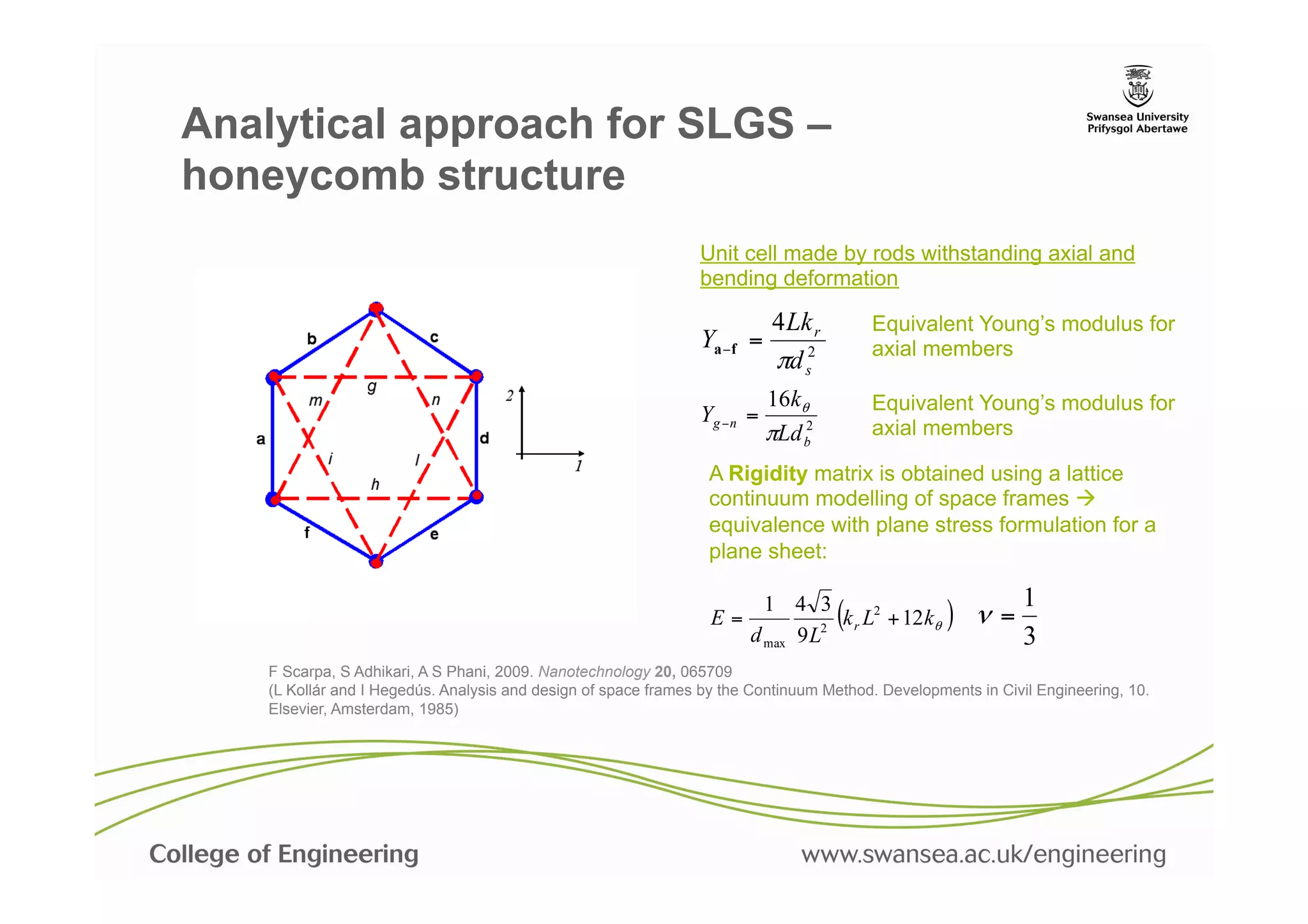
![Atomistic FE – Bilayer Graphene
• Equivalent to structural “sandwich” beams
• C-C bonds in graphene layers represented with
classical equivalent beam models
• “Core” represented by Lennard-Jones potential
interactions:
rmin = 0.383 nm
ε = 2.39 meV
Ef =0.5 TPa (I.W. Frank, D.M. Tanenbaum, A.M. van der Zande,
P.L. McEuen, J. Vac. Sci. Technol. B 25 (2007) 2558)
Scarpa, F., Adhikari, S. and Chowdhury, R., "The transverse elasticity of bilayer
graphene", Physics Letters A, 374[19-20] (2010), pp. 2053-2057.](https://image.slidesharecdn.com/nanomechsd-pptx-130121050031-phpapp02/75/Statics-and-dynamics-of-nanoscale-structures-32-2048.jpg)
![Mechanical vibration of SLGS
Lumped mass matrix:
Minimisation of the Hamiltonian for the ith mode:
Comparison against Molecular Mechanics
model based on the eigenvalue analysis of
the system Hessian matrix
Scarpa, F., Chowdhury, R., Kam, K., Adhikari, S. and Ruzzene, M., "Wave propagation in graphene nanoribbons", Nanoscale Research
Letters, 6 (2011), pp. 430:1-10.
Chowdhury, R., Adhikari, S., Scarpa, F. and Friswell, M. I., "Transverse vibration of single layer graphene sheets", Journal of Physics D:
Applied Physics, 44[20] (2011), pp. 205401:1-11.](https://image.slidesharecdn.com/nanomechsd-pptx-130121050031-phpapp02/75/Statics-and-dynamics-of-nanoscale-structures-33-2048.jpg)
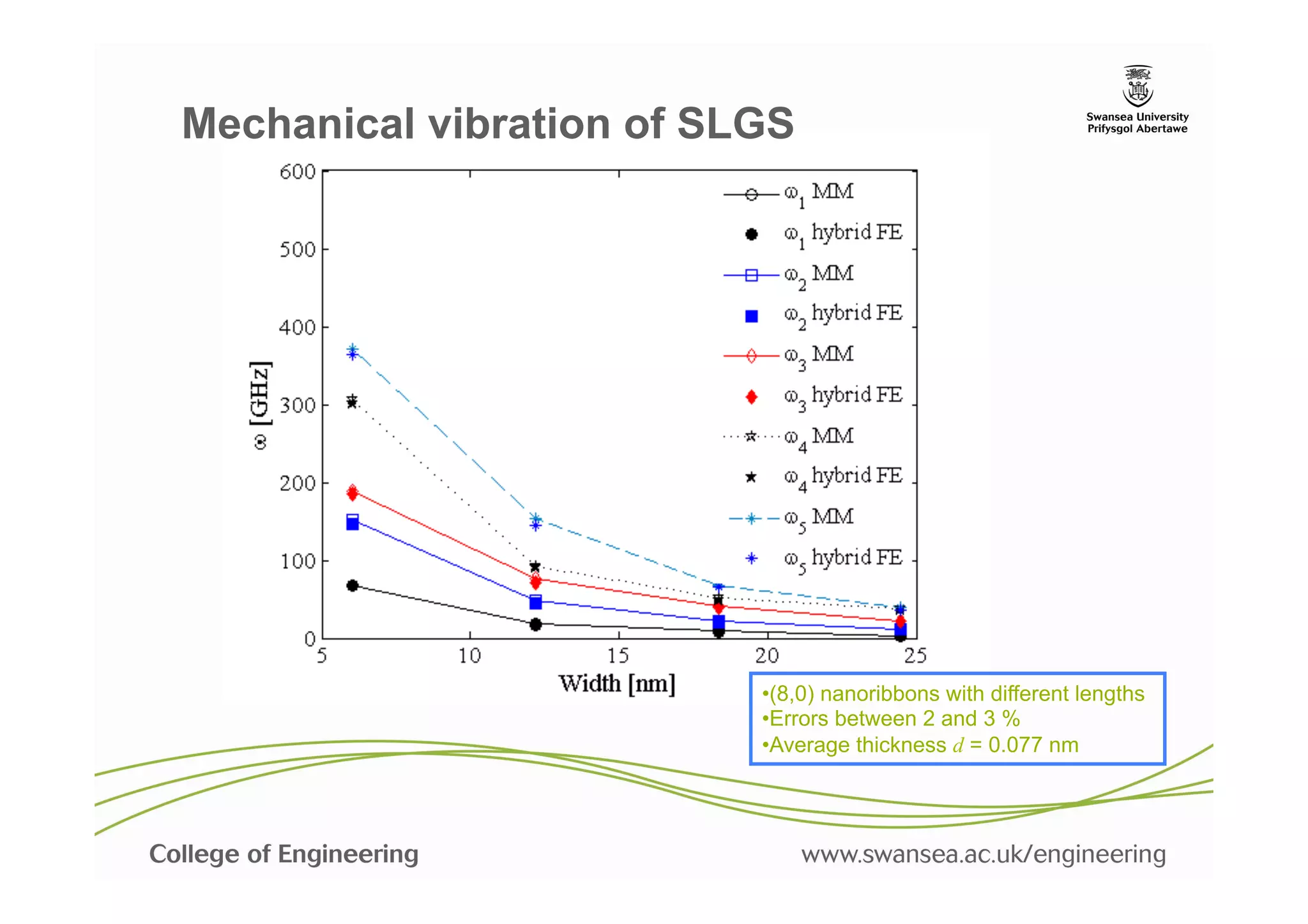

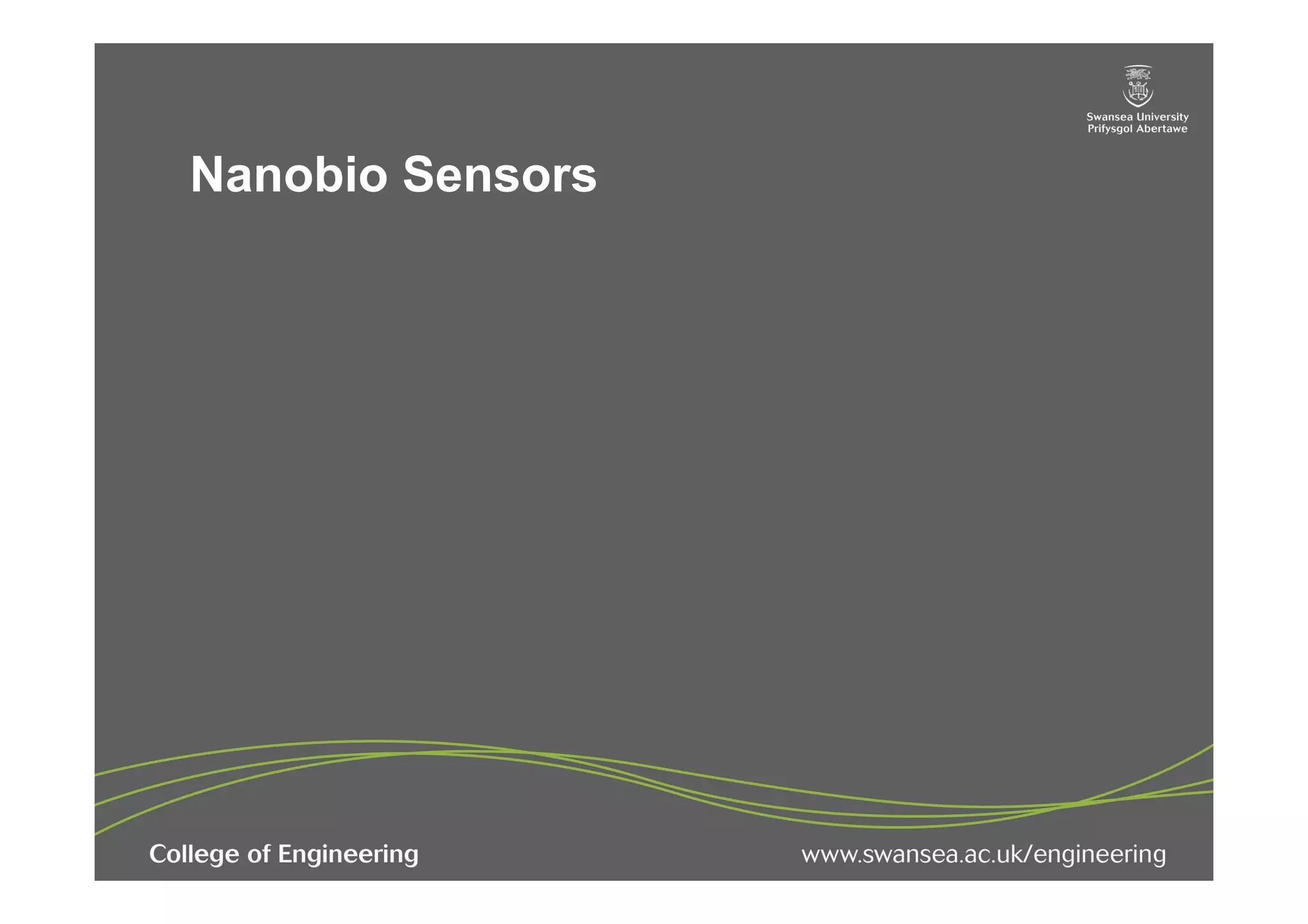
![Vibration based mass sensor: CNT
Point mass Distributed mass
Chowdhury, R., Adhikari, S. and Mitchell, J., "Vibrating carbon
nanotube based bio-sensors", Physica E: Low-dimensional Adhikari, S. and Chowdhury, R., "The calibration of carbon
Systems and Nanostructures, 42[2] (2009), pp. 104-109. nanotube based bio-nano sensors", Journal of Applied Physics,
107[12] (2010), pp. 124322:1-8](https://image.slidesharecdn.com/nanomechsd-pptx-130121050031-phpapp02/75/Statics-and-dynamics-of-nanoscale-structures-37-2048.jpg)
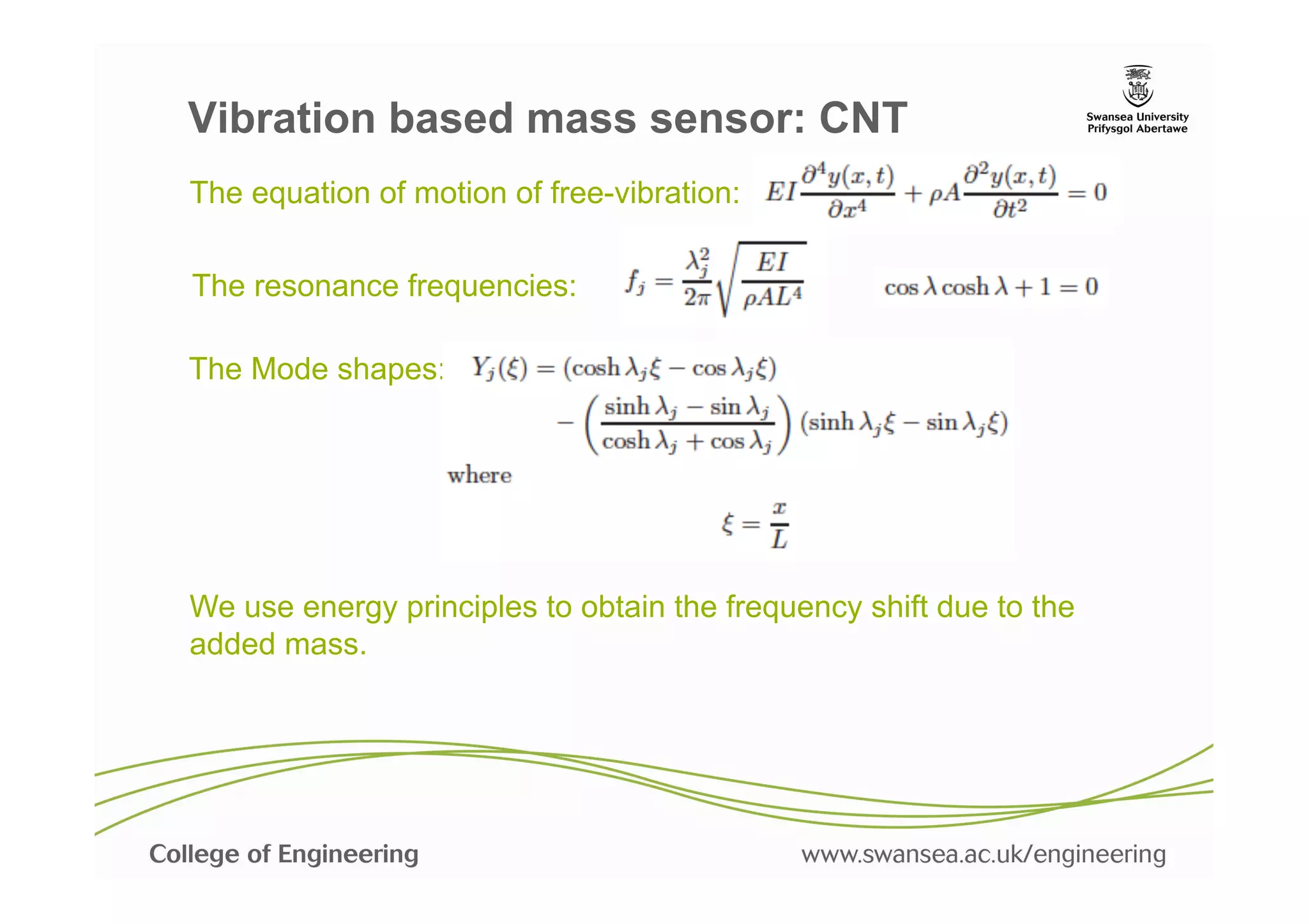
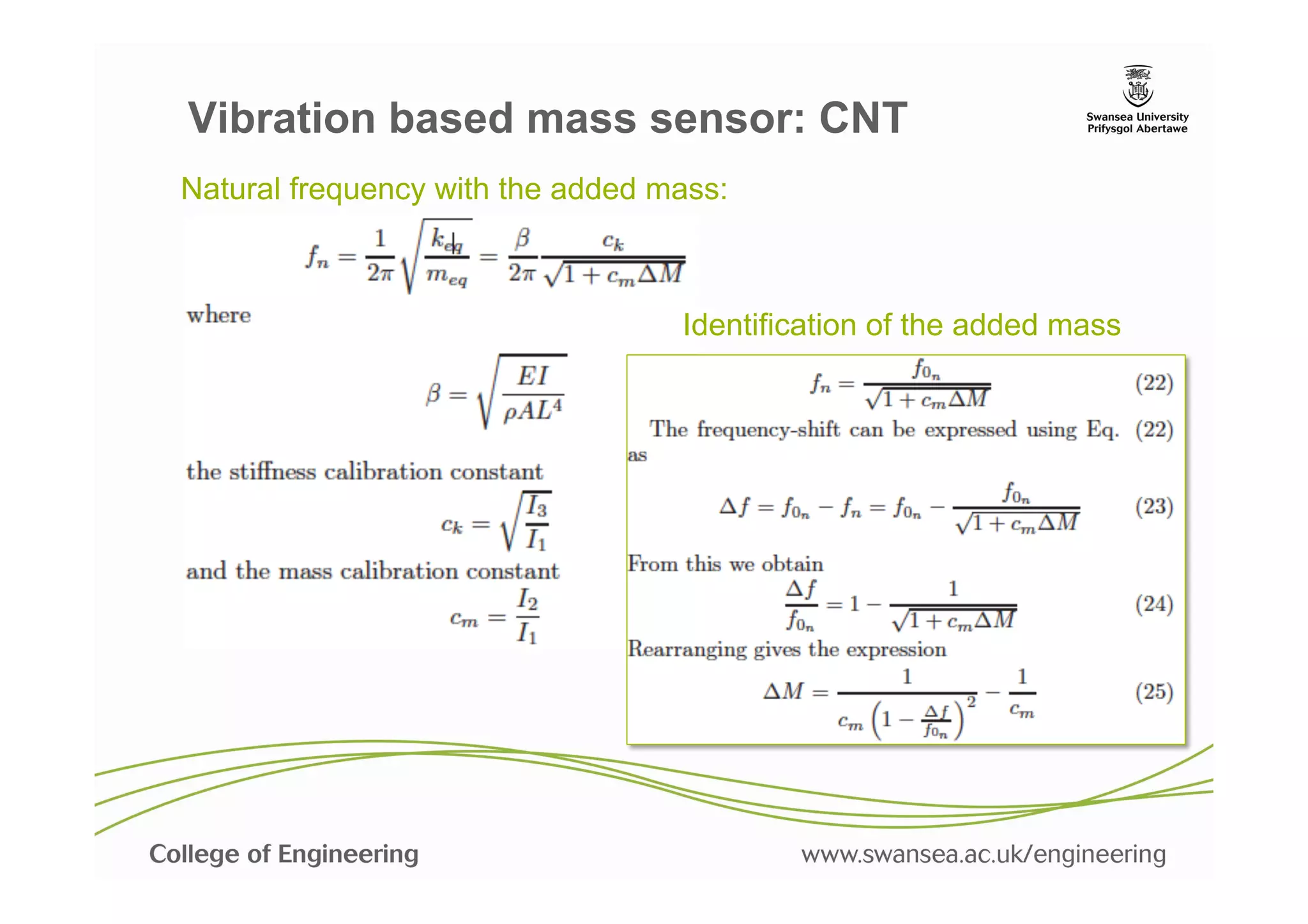
![Vibration based mass sensor: CNT
Mass of a nano object can be detected from the frequency shift Δf
Adhikari, S. and Chowdhury, R., "The calibration of carbon nanotube based
bio-nano sensors", Journal of Applied Physics, 107[12] (2010), pp.
124322:1-8](https://image.slidesharecdn.com/nanomechsd-pptx-130121050031-phpapp02/75/Statics-and-dynamics-of-nanoscale-structures-40-2048.jpg)
![Vibration based mass sensor: CNT
Mass of a nano object can be detected from the frequency shift Δf
0.45
0.4 Molecular mechanics
Exact solution
0.35 Calibration constant based approach
AL
0.3
Normalized added mass: M /
0.25
0.2
0.15
CNT with deoxythymidine 0.1
0.05
Adhikari, S. and Chowdhury, R., "The calibration of carbon nanotube based 0
0 0.05 0.1 0.15 0.2 0.25 0.3 0.35 0.4
bio-nano sensors", Journal of Applied Physics, 107[12] (2010), pp. Relative frequency shift: f / f
124322:1-8
n0](https://image.slidesharecdn.com/nanomechsd-pptx-130121050031-phpapp02/75/Statics-and-dynamics-of-nanoscale-structures-41-2048.jpg)

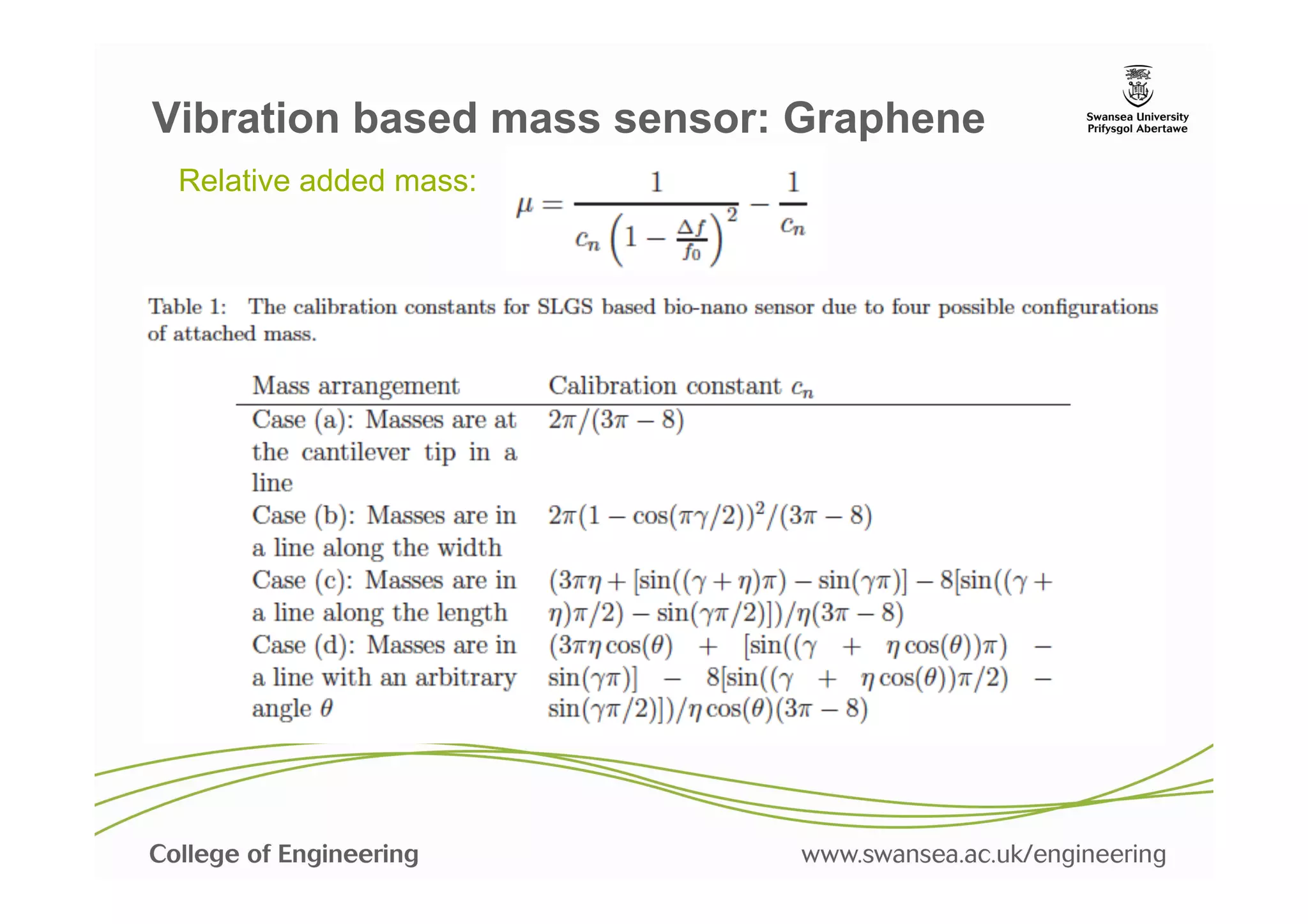
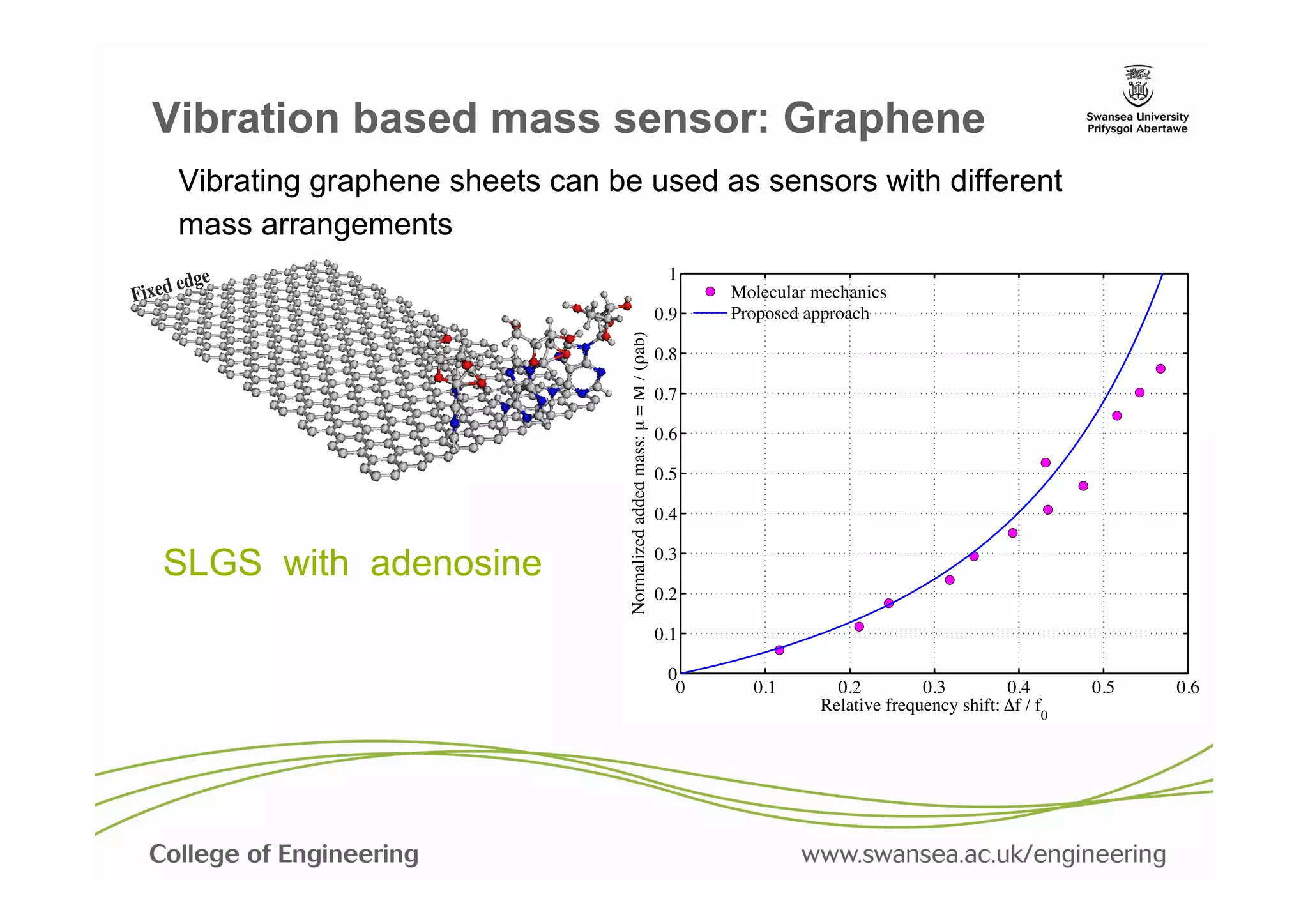
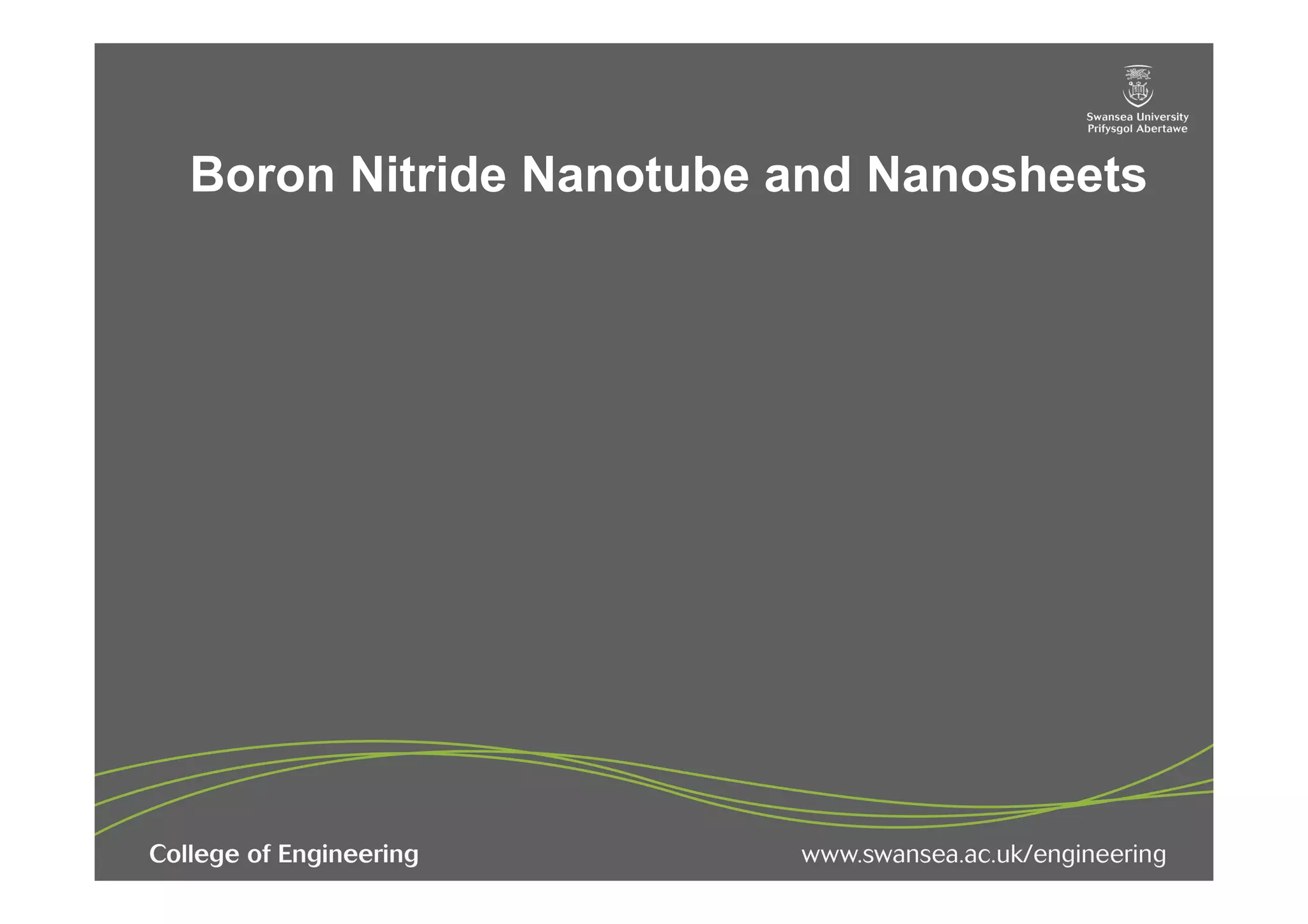
![Axial vibration of BNNT
(a)
(a) Axial vibration and its
associated frequency of (b)
zigzag and (c) armchair
BNNTs given by the MM
simulations (discrete dots)
and a column model with
Young’s modulus 1TPa
!
(solid lines). Chowdhury, R., Wang, C. W., Adhikari, S. and Scarpa, F., "Vibration and symmetry-breaking
of boron nitride nanotubes", Nanotechnology, 21[36] (2010), pp. 365702:1-9.](https://image.slidesharecdn.com/nanomechsd-pptx-130121050031-phpapp02/75/Statics-and-dynamics-of-nanoscale-structures-46-2048.jpg)
![Torsional vibration of BNNT
(a)
(a) Torsional vibration and its
associated frequency of (b) zigzag
and (c) armchair BNNTs given by
the MM simulations (discrete dots)
and a column model with shear
modulus 0.41TPa (solid lines).
!
Chowdhury, R., Wang, C. W., Adhikari, S. and Scarpa, F., "Vibration and symmetry-breaking
of boron nitride nanotubes", Nanotechnology, 21[36] (2010), pp. 365702:1-9.](https://image.slidesharecdn.com/nanomechsd-pptx-130121050031-phpapp02/75/Statics-and-dynamics-of-nanoscale-structures-47-2048.jpg)
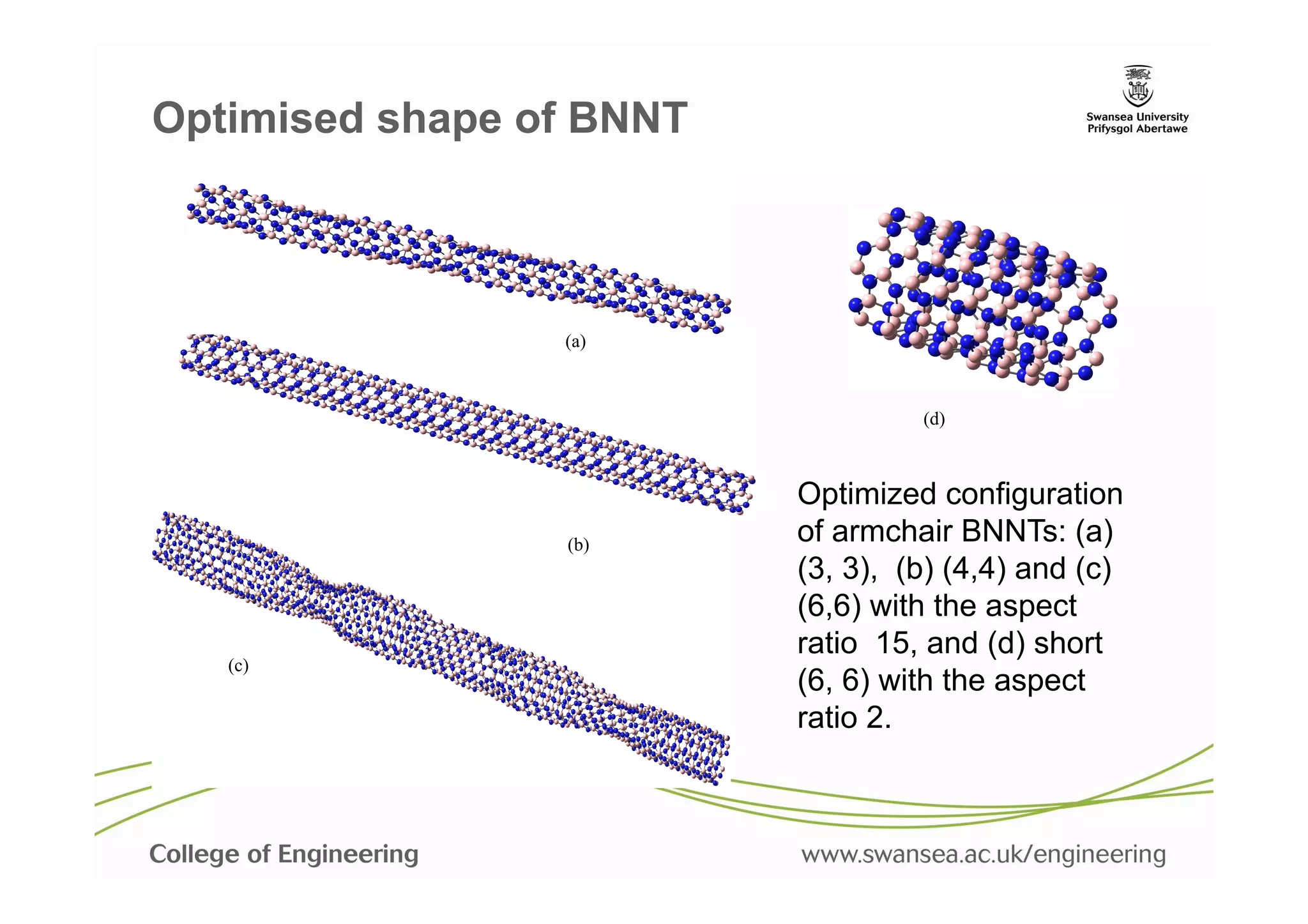
![Mechanical property of BN Sheets
Example of armchair (4, 0) BN sheet.
Boron atoms are in red, nitrogen
atoms are in green. Boldrin, L., Scarpa, F., Chowdhury, R., Adhikari, S. and Ruzzene, M., "Effective mechanical
properties of hexagonal boron nitride nanosheets", Nanotechnology, 22[50] (2011), pp.
505702:1-7.](https://image.slidesharecdn.com/nanomechsd-pptx-130121050031-phpapp02/75/Statics-and-dynamics-of-nanoscale-structures-49-2048.jpg)

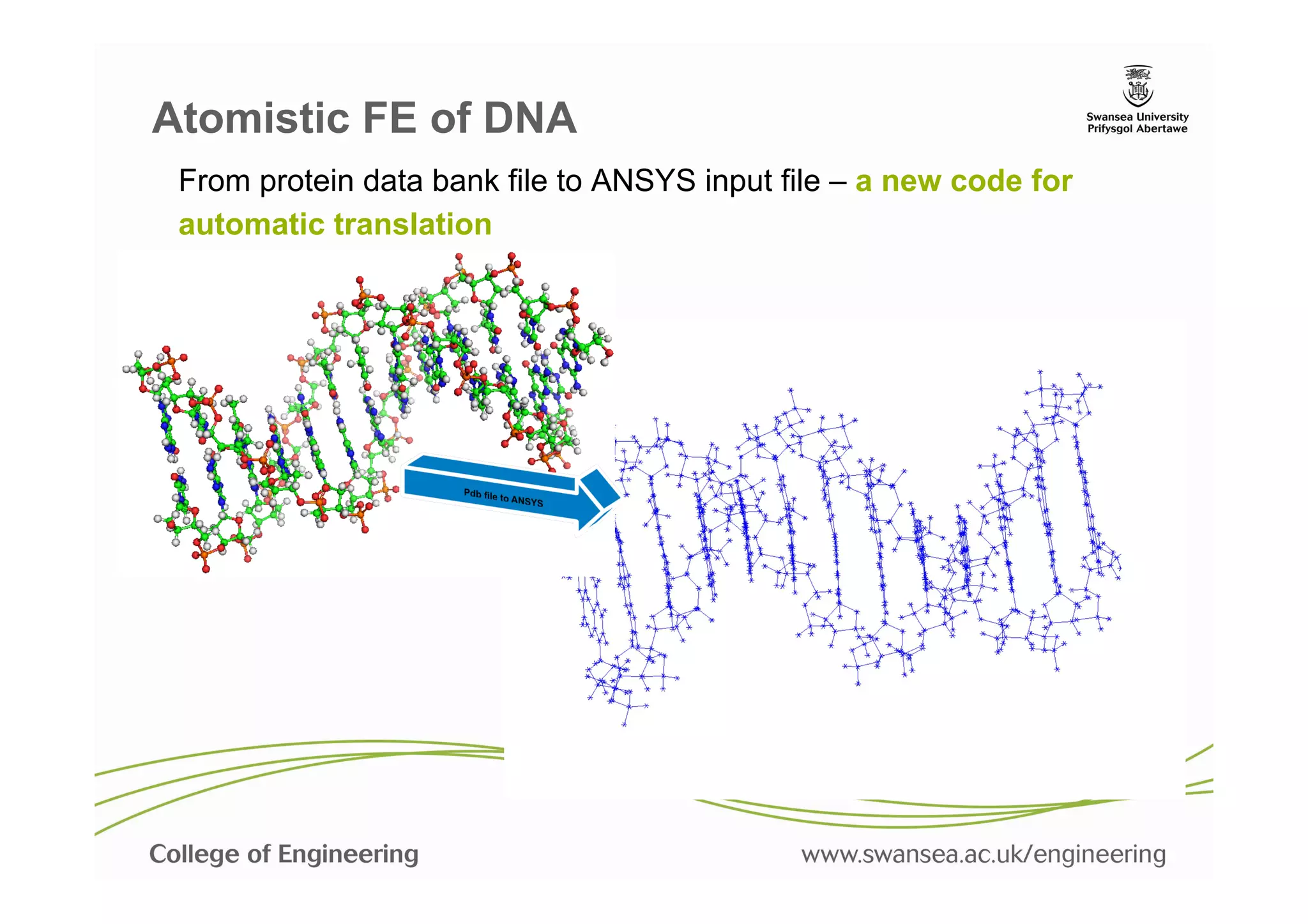
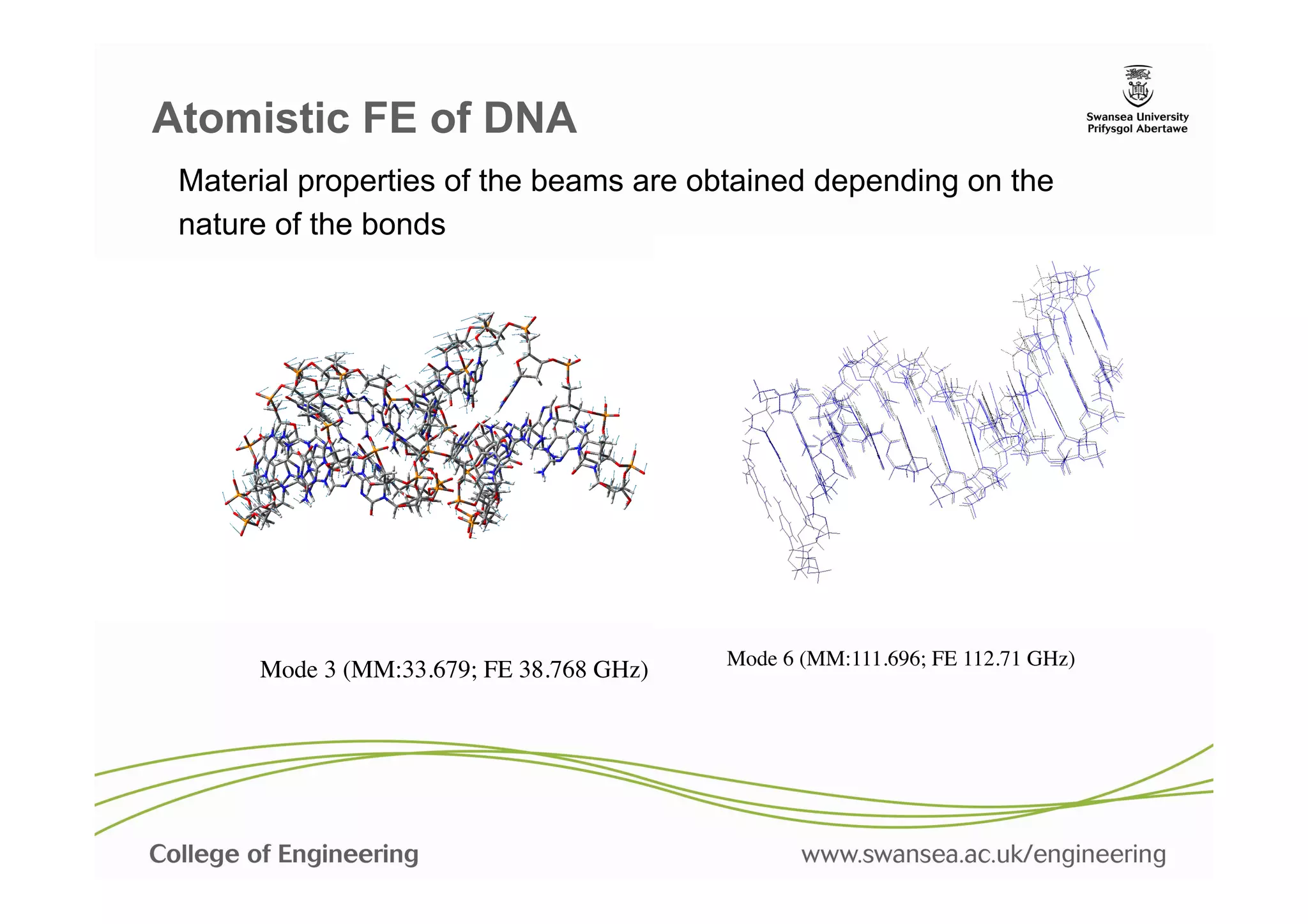
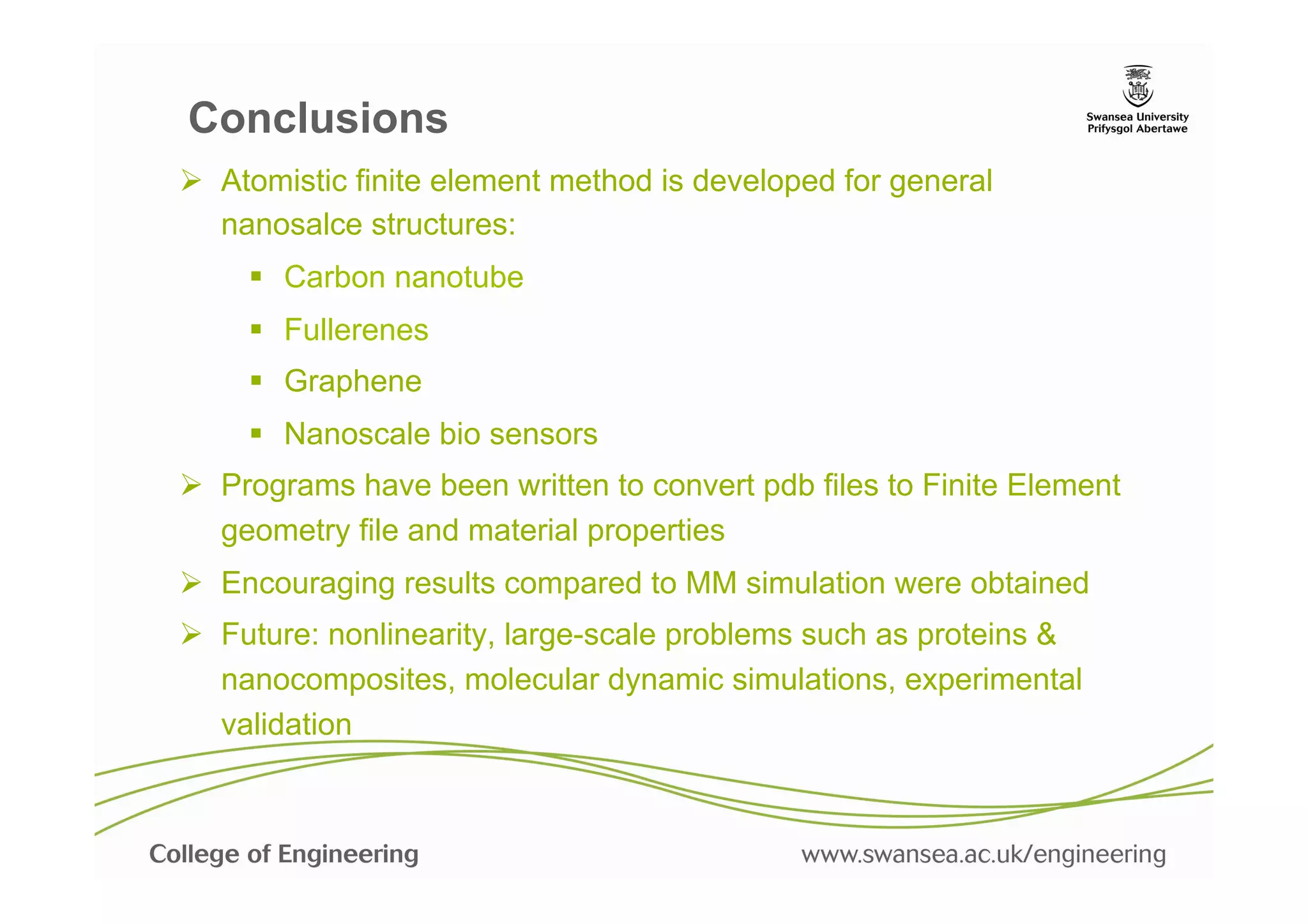
![References
1. Murmu, T. and Adhikari, S., "Nonlocal frequency analysis of nanoscale biosensors", Sensors & Actuators: A.
Physical, 173[1] (2012), pp. 41-48.
2. Boldrin, L., Scarpa, F., Chowdhury, R., Adhikari, S. and Ruzzene, M., "Effective mechanical properties of
hexagonal boron nitride nanosheets", Nanotechnology, 22[50] (2011), pp. 505702:1-7.
3. Murmu, T., Seinz, J., Adhikari, S. and Arnold, C., "Nonlocal buckling behaviour of bonded double-nanoplate-
system", Journal of Applied Physics, 110[8] (2011), pp. 084316:1-8.
4. Flores, E. I. S., Adhikari, S., Friswell, M. I. and Scarpa, F., "Hyperelastic axial buckling of single wall carbon
nanotubes", Physica E: Low-dimensional Systems and Nanostructures, 44[2] (2011), pp. 525-529.
5. Murmu, T. and Adhikari, S., "Nonlocal vibration of bonded double-nanoplate-systems", Composites Part B:
Engineering, 42[7] (2011), pp. 1901-1911.
6. Chandra, Y., Chowdhury, R., Adhikari, S. and Scarpa, F., "Elastic instability of bilayer graphene using atomistic
finite element", Physica E: Low-dimensional Systems and Nanostructures, 44[1] (2011), pp. 12-16.
7. Scarpa, F., Chowdhury, R., Kam, K., Adhikari, S. and Ruzzene, M., "Wave propagation in graphene
nanoribbons", Nanoscale Research Letters, 6 (2011), pp. 430:1-10.
8. Chowdhury, R. and Adhikari, S., "Boron nitride nanotubes as zeptogram-scale bio-nano sensors: Theoretical
investigations", IEEE Transactions on Nanotechnology, 10[4] (2011), pp. 659-667.
9. Chandra, Y., Chowdhury, R., Scarpa, F. and Adhikari, S., "Vibrational characteristics of bilayer graphene
sheets", Thin Solid Films, 519[18] (2011), pp. 6026-6032.
10. Adhikari, S. and Chowdhury, R., "Vibration spectra of fullerene family", Physics Letters A, 375[22] (2011), pp.
1276-1280.](https://image.slidesharecdn.com/nanomechsd-pptx-130121050031-phpapp02/75/Statics-and-dynamics-of-nanoscale-structures-54-2048.jpg)
![References
11. Murmu, T., Adhikari, S. and Wang, C. W., "Torsional vibration of carbon nanotube-buckyball systems based on
nonlocal elasticity theory", Physica E: Low-dimensional Systems and Nanostructures, 43[6] (2011), pp.
1276-1280.
12. Wang, C. W. and Adhikari, S., "ZnO-CNT composite nanowires as nanoresonators", Physics Letters A, 375[22]
(2011), pp. 2171-2175.
13. Chowdhury, R., Adhikari, S., Scarpa, F. and Friswell, M. I., "Transverse vibration of single layer graphene
sheets", Journal of Physics D: Applied Physics, 44[20] (2011), pp. 205401:1-11.
14. Scarpa, F., Chowdhury, R., and Adhikari, S., "Thickness and in-plane elasticity of Graphane", Physics Letters
A, 375[20] (2011), pp. 2071-2074.
15. Wang, C. W., Murmu, T. and Adhikari, S., "Mechanisms of nonlocal effect on the vibration of nanoplates",
Applied Physics Letters, 98[15] (2011), pp. 153101:1-3.
16. Murmu, T. and Adhikari, S., "Nonlocal vibration of carbon nanotubes with attached buckyballs at tip",
Mechanics Research Communications, 38[1] (2011), pp. 62-67.
17. Chowdhury, R., Adhikari, S. and Scarpa, F., "Vibrational analysis of ZnO nanotubes: A molecular mechanics
approach", Applied Physics A, 102[2] (2011), pp. 301-308.
18. Chowdhury, R., Adhikari, S., Rees, P., Scarpa, F., and Wilks, S.P., "Graphene based bio-sensor using
transport properties", Physical Review B, 83[4] (2011), pp. 045401:1-8.
19. Murmu, T. and Adhikari, S., "Axial instability of double-nanobeam-systems", Physics Letters A, 375[3] (2011),
pp. 601-608.
20. Flores, E. I. S., Adhikari, S., Friswell, M. I. and F. Scarpa, "Hyperelastic finite element model for single wall
carbon nanotubes in tension", Computational Materials Science, 50[3] (2011), pp. 1083-1087.](https://image.slidesharecdn.com/nanomechsd-pptx-130121050031-phpapp02/75/Statics-and-dynamics-of-nanoscale-structures-55-2048.jpg)
![References
21. Murmu, T. and Adhikari, S., "Scale-dependent vibration analysis of prestressed carbon nanotubes undergoing
rotation", Journal of Applied Physics, 108[12] (2010), pp. 123507:1-7.
22. Scarpa, F., Adhikari, S. and Phani, A. Srikanth, "Auxeticity in single layer graphene sheets", International
Journal of Novel Materials, 1[2] (2010), pp. 39-43.
23. Murmu, T. and Adhikari, S., "Nonlocal effects in the longitudinal vibration of double-nanorod systems", Physica
E: Low-dimensional Systems and Nanostructures, 43[1] (2010), pp. 415-422.
24. Murmu, T. and Adhikari, S., "Nonlocal transverse vibration of double-nanobeam-systems", Journal Applied
Physics, 108[8] (2010), pp. 083514:1-9.
25. Scarpa, F., Peng, H. X., Boldri, L., Remillat, C. D. L., Adhikari, S., "Coupled thermo-mechanics of single-wall
carbon nanotubes", Applied Physics Letters, 97[15] (2010), pp. 151903:1-3.
26. Chowdhury, R., Adhikari, S., Rees, P., "Optical properties of silicon doped ZnO", Physica B: Condensed
Matter, 405[23] (2010), pp. 4763-4767.
27. Chowdhury, R., Wang, C. W., Adhikari, S. and Scarpa, F., "Vibration and symmetry-breaking of boron nitride
nanotubes", Nanotechnology, 21[36] (2010), pp. 365702:1-9.
28. Wang, C. Y., Zhao, Y., Adhikari, S. and Feng, Y. T., "Vibration of axially strained triple-wall carbon nanotubes",
Journal of Computational and Theoretical Nanoscience, 7[11] (2010), pp. 2176-2185.
29. Adhikari, S. and Chowdhury, R., "The calibration of carbon nanotube based bio-nano sensors", Journal of
Applied Physics, 107[12] (2010), pp. 124322:1-8.
30. Chowdhury, R., Wang, C. Y., Adhikari, S., and Tong, F. M., "Sliding oscillations of multiwall carbon nanotubes",
Physica E: Low-dimensional Systems and Nanostructures, 42[9] (2010), pp. 2295-2300.](https://image.slidesharecdn.com/nanomechsd-pptx-130121050031-phpapp02/75/Statics-and-dynamics-of-nanoscale-structures-56-2048.jpg)
![References
31. Chowdhury, R., Adhikari, S., Wang, C. W. and Scarpa, F., "A molecular mechanics approach for the vibration
of single walled carbon nanotubes", Computational Materials Science, 48[4] (2010), pp. 730-735.
32. Wang, C. Y., Li, C. F., and Adhikari, S., "Axisymmetric vibration of singlewall carbon nanotubes in water",
Physics Letters A, 374[24] (2010), pp. 2467-2474.
33. Chowdhury, R., Adhikari, S. and Scarpa, F., "Elasticity and piezoelectricity of zinc oxide nanostructure",
Physica E: Low-dimensional Systems and Nanostructures, 42[8] (2010), pp. 2036-2040.
34. Gil, A. J., Adhikari, S., Scarpa, F., and Bonet, J., "The formation of wrinkles in single layer graphene sheets
under nanoindentation", Journal of Physics: Condensed Matter, 22[14] (2010), pp. 145302:1-6.
35. Scarpa, F., Adhikari, S. and Chowdhury, R., "The transverse elasticity of bilayer graphene", Physics Letters A,
374[19-20] (2010), pp. 2053-2057.
36. Scarpa, F., Adhikari, S., Gil, A. J. and Remillat, C., "The bending of single layer graphene sheets: Lattice
versus continuum approach", Nanotechnology, 21[12] (2010), pp. 125702:1-9.
37. Chowdhury, R., Rees, P., Adhikari, S., Scarpa, F., and Wilks, S.P., "Electronic structures of silicon doped ZnO",
Physica B: Condensed Matter, 405[8] (2010), pp. 1980-1985.
38. Scarpa, F., Adhikari, S. and Wang, C. Y., "Nanocomposites with auxetic nanotubes", International Journal of
Smart and Nanomaterials, 1[2] (2010), pp. 83-94.
39. Chowdhury, R., Wang, C. Y. and Adhikari, S., "Low-frequency vibration of multiwall carbon nanotubes with
heterogeneous boundaries", Journal of Physics D: Applied Physics, 43[11] (2010), pp. 085405:1-8.
40. Chowdhury, R., Adhikari, S. and Mitchell, J., "Vibrating carbon nanotube based bio-sensors", Physica E: Low-
dimensional Systems and Nanostructures, 42[2] (2009), pp. 104-109.](https://image.slidesharecdn.com/nanomechsd-pptx-130121050031-phpapp02/75/Statics-and-dynamics-of-nanoscale-structures-57-2048.jpg)
![References
41. Scarpa, F., Adhikari, S. and Wang, C. Y., "Mechanical properties of non reconstructed defective single wall
carbon nanotubes", Journal of Physics D: Applied Physics, 42 (2009) 142002 (6pp).
42. Wang, C. Y., Li, C. F., and Adhikari, S., "Dynamic behaviors of microtubules in cytosol", Journal of
Biomechanics, 42[9] (2009), pp. 1270-1274.
43. Tong, F. M., Wang, C. Y., and Adhikari, S., "Axial buckling of multiwall carbon nanotubes with heterogeneous
boundary conditions", Journal of Applied Physics, 105 (2009), pp. 094325:1-7.
44. Scarpa, F., Adhikari, S. and Phani, A. Srikanth, "Effective mechanical properties of single graphene sheets",
Nanotechnology, 20[1-2] (2009), pp. 065709:1-11.
45. Scarpa, F. and Adhikari, S., "Uncertainty modelling of carbon nanotube terahertz oscillators", Journal of Non-
Crystalline Solids, 354[35-39] (2008), pp. 4151-4156.
46. Scarpa, F. and Adhikari, S., "A mechanical equivalence for the Poisson's ratio and thickness of C-C bonds in
single wall carbon nanotubes", Journal of Physics D: Applied Physics, 41 (2008) 085306 (5pp).](https://image.slidesharecdn.com/nanomechsd-pptx-130121050031-phpapp02/75/Statics-and-dynamics-of-nanoscale-structures-58-2048.jpg)